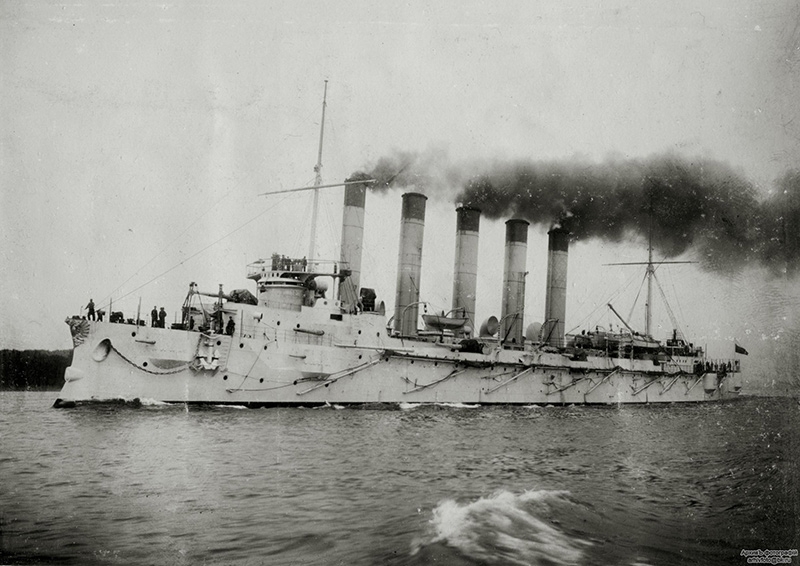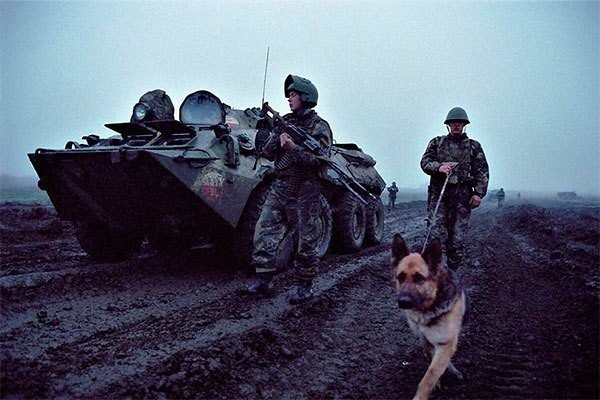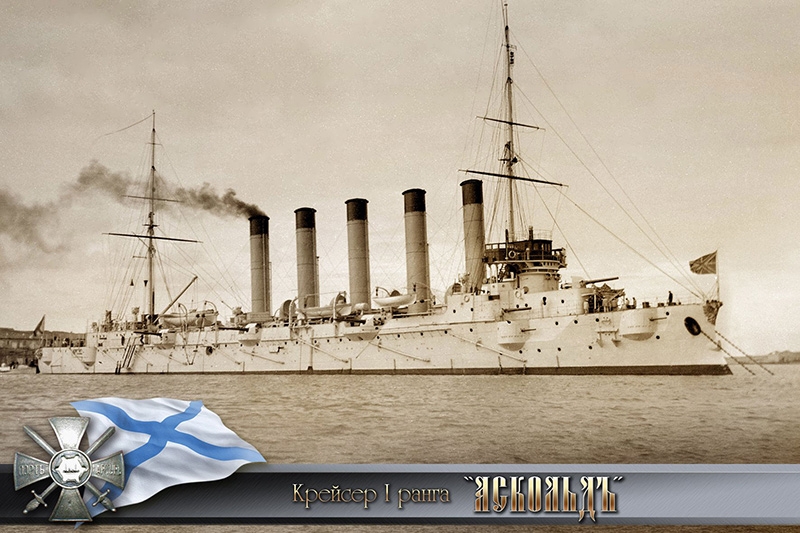
"Askold" - bronepalubnыy cruiser 1 rank, He was a member of the 1st Pacific Squadron based at Port Arthur, He participated in Russian-Japanese War and in World War I. The name is inherited from the cruiser sailing screw corvette, and supremely approved 21 December 1898 g. - in honor of the legendary prince of Kiev Askold.
Japan's victory over China in the war of 1894-1895 fundamentally changed the balance of forces in the Far East. The increasing power of the victorious gradually began to threaten the interests of Russia. Japanese shipbuilding programs include a significant increase in the fleet. In this regard, in St. Petersburg at the special meetings of the Naval Department leadership and some reputable admirals in December 1897 It has been defined the necessary composition of the Russian squadron in the Pacific Ocean 1903 year: 10 battleships, 4 bronenosnыh and kreysera 20 cruisers reconnaissance. the last number is determined from the received opinion in th time in the foreign fleets, that each battleship in the squadron should fall 2-3 scout two types: "Distant" (1 rank) displacement 5000- 6000 t and "The Middle" (2 rank) a 2000 2500 t.
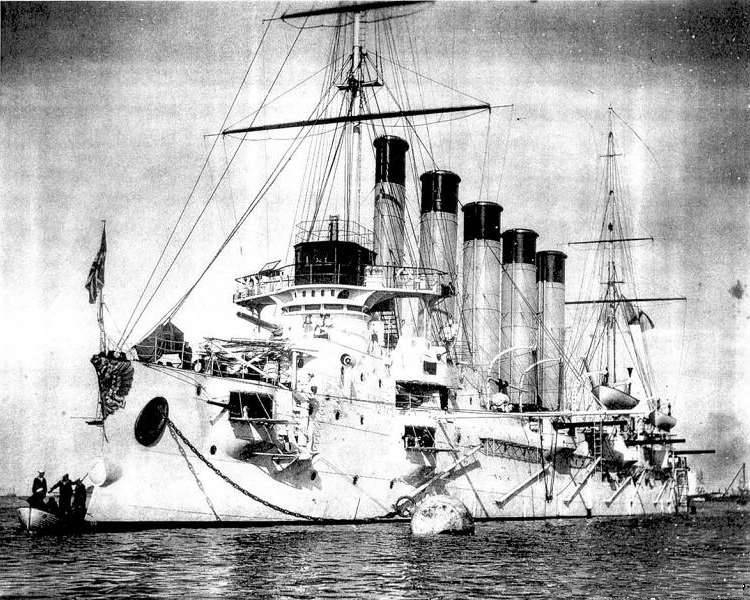
special meeting admirals Journal was approved by Nicholas II 20 February 1898 of the year, and immediately managed marine ministry P.P.Tyrtov commanded the Naval Technical Committee (MTK) develop a design assignment (then they were called "the design of the program") new ships. Displacement of distal scout savings considerations limited 6000 t, full speed was set relatively high for the time -23 host. Armament was to consist of 12 152-mm 12 75-mm guns. Artillery Division ITC considered, that more rapid-152mm tools provide greater firepower, than the 2203-MMI 10 120-mm guns from potential enemies Japanese kreysorov type “Kasagi”.
Given the limited displacement, strong arms and considerable reserves of fuel it was impossible to combine with strong armor protection. Therefore, immediately I had to give up the armor belt at the waterline and limit karapasnoy armored deck. In early April, an invitation to participate in the design competition with “programs to design” They were sent to foreign and Russian plants. But the contract for the construction of the first cruiser - “Varangian” -signed without competition 11 April, arrived in St. Petersburg chapter of the American firm “William Cramp & Sons”
Projects of the remaining plants were carefully studied by experts MTC departments. 3 July held its final meeting for the final discussion of projects, submitted to the contest Nevsky Zavod (Russia), shipyards “Germany”, “Şixau”, “Hovaldsverke” (Germany) and “Ansaldo” (Italy). The best recognized shipyard project “Germany” in Kile, A major concern prynadlezhavshey. I agreed with this opinion General Admiral, and his report 27 July was Nicholas II received permission to order a second cruiser Krupp. 4 August Joint shipbuilding and mechanical plants “Germany” and Marine Ministry entered into a contract.
Alas, belatedly entered the competition by an English project, and one German - firms “Volcano”. First provisionally awarded fourth place in the MTC, and the last recognized even better, than the shipyard project “Germany”. After that “Volcano” ordered third cruiser, later was named “hero”. In this way, in the US and in Germany three different plants for the original project, but on a single task three cruisers built for the Russian Imperial Fleet. As a result of this distribution fleet orders quickly added not only new ships, and modern examples of shipbuilding different "schools of shipbuilding". Selecting the best of them, It was supposed to begin serial production of cruisers at domestic plants.
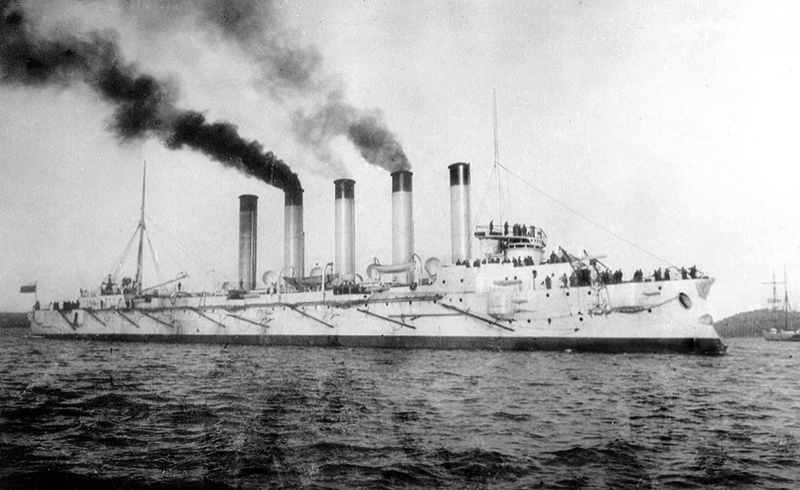
Construction and testing
Under the contract, the firm had to build a cruiser for 3.78 million. rubles (8,2 million. German brands) unarmed value and pass it through a special selection committee 23 months from the date of contract signing. The entire amount was divided into 10 equal payments, payable as ship construction. For failure to comply terms of the contract provides for penalties, wherein fines shortage rate is significantly higher than penalties for non-delivery deadlines. So, eg, in the case of the average speed less cruiser 21, but more 20 nodes withheld from firms 25% payment amount, as for delay in delivery - 1% for each month of delay. If there was less speed 20 knots, the Ministry of the Navy could opt out of the ship.
the Company management considered the order to Russia as a prestigious and promotional purposes cruiser tried to build faster and better than competitors. Therefore, the work at the shipyard began 24 October 1898goda, when it arrived from the steel mills in Essen first metal party in Kiel for ship constructions, that is, prior to the approval of detailed drawings of the customer. Maritime agent in Germany Lieutenant A.K.Polis said on the Naval Staff, what to 1 November keel cruiser was already ready for a full-length, exhibited 1/3 frames and started assembly of machine foundations. Meanwhile, in the ITC found in the submitted a month before drawing a lot of flaws, and calculations of strength and stability in the project non-existent. Therefore, to solve all problems 29 December arrived in St. Petersburg company director – they are also authors of the project: Rauhfus (to the body) and Schultz (mechanical installation). Calculation of the ITC experts on the, that significant changes can be made to the draft, not justified, since the bottom was ready, frames brought to the height of the armored deck, there are four outer skin belt. The Germans categorically refused to do forecastle, not to dismantle the already collected and fear get the trim on the nose MTC had to agree, although it reduced the seaworthiness. As a result, we adopted a compromise solution - nasal superstructure extended forward and lifted her tanks (per unit length) 152-mm gun. It turned, that the project as compared to the number of design drawings of transverse watertight bulkheads reduced from 16 to 12 double bottom and left only in the engine and boiler rooms. Double bottom has been restored along the entire length of the ship, but the number of bulkheads increase was no longer possible – I would have to re reschedule all interior. Here MTC had to give, but the committee still took revenge for a variety of positions; after stubborn resistance, the firm agreed to the hopper side keels, longitudinal bulkhead under the armored deck over the engine and boiler rooms, distribution board 152-mm shells, thickening in some areas of decks and a number of other. Naval Ministry had to pay extra for the use of stalenikelevoy Krupp armor, since it was not included and timely contract.
A lot of controversy was the issue of chimneys. Shipbuilding department MTC required to reduce their number, to reduce the area of the target and felting cruiser under the wind out of the large sail bow. Engineer Schultz refused to remove at least one pipe, even the thinnest – front, fear, it will reduce the speed by one unit. He was supported by the mechanical department, and the ship was five-funnel. Since Kiel continued in full swing work on the stocks, after persistent disputes on each item specification and drawings of the MTC 19 January 1899 I have been forced to approve the project with 55 any comments and additions.
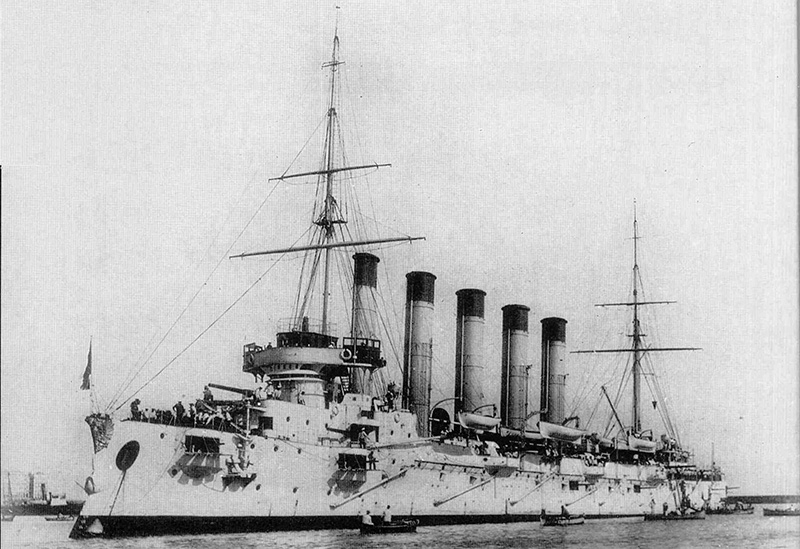
Yet 21 December 1898 the cruiser was named after "Askold" in honor of the prince, who ruled in Kiev in the second half of the IX century, and under whose leadership the first trip to Constantinople was committed. The name "Askold" wore a 46-gun frigate, Launched in St. Petersburg New Admiralty 6 July 1854 year and exploded in Kronstadt 1861 year. Then his name was transferred to the corvette, Launched on 15 October Okhtinsky shipyard 1863 of the year. The second "Askold" was excluded from the lists of the fleet in thirty years. The third ship with this name - cruiser 1 rank - enlisted in the Navy List 11 January 1899 of the year, and its official laying took only six months, 8 July without ceremony. Direct control over the progress of construction at the shipyard carried out “observing” Commission headed by Captain 1 rank N.K.Reytsenshteynom, then became the first commander "Askolda". Commission members are not only meticulously monitored compliance by the contract and specifications, but also makes a lot of proposals for improving cruiser, of its internal mechanisms and devices.
2 Martha 1900 the corps was successfully launched, commencement of loading and installation of mechanical installations. The company boosted construction: increased the number of workers, working hours reached 20 hours of the fall of all boilers and machines were installed and assembled, deck riveted and engrave, Home Equipment cabins and various facilities. Delivered batch of Russian team together with the officers of all the working time spent on the ship. By the anniversary of the descent into the water externally cruiser looked almost ready: among the many ships in Kiel, he stood out for its five elegant thin tubes. We are standing on the ground 152 mm cannon, bridges, mast. Inside the continued hard work to prepare for the mooring trials mechanisms.
11 April 1901 , a new ship for the first time went to sea. Started production tests. Due to malfunction of nutrient pumps failed to raise the vapor pressure of more than 14 atm, nevertheless developed cruiser speed 18.25 host, that was not so bad for the first exit. Members of the observing commission drew attention to the strong vibration. At their request, work began on the bridge reinforcement, Although engineers have felt the vibration of not going beyond, typical high-speed ships. 23 May cruiser's return to the factory testing, which we had hoped to reach a contractual rate. But the machines were working with a thud, vibration force. I had to sort out the bearings and make a thorough inspection mechanisms. Next, 9 June, machine worked much better and the cruiser made its first transition at the Kiel Canal in Hamburg on docking and back to Kiel is already around the Jutland Peninsula. 24 July selection committee officially started its work. Shooting from the 152-mm shells revealed insufficient strength bridging structure, cuttings, nadstroek, were damaged.
6 September "Askold" was released on the official test at the Danzig dimensional mile. The factory provided test selected fresh Cardiff coal and most experienced stokers. in vodoizmeshtenii 5950 so the average speed of the four runs on 2 miles was 23,39 host, and average power 19 601 l is., maximum speed exceeded 24 host. 15 and 17 It took place on September 6-hour test. The average rate was respectively 23,59 and 23,83 host, maximum – 23.98 and 24,01 unit at maximum power 21 100 and 20 885 HP. After the elimination of small malfunctions 3 November cruiser came on an additional test and developed the record power – 23 500 HP. Machine running smoothly, without knocking in bearings and a pair of etching, significantly reduced vibration. Across 2 o'clock 20 minutes full speed Commission, make sure to follow all the terms of the contract, said the end of the running acceptance tests. “Navy gets most high-speed cruiser in the world”,- I wrote in one of his reports Reytsentshteyn. 17 November Russian team moved to the cruiser and launched a full service all mechanisms. Official acceptance continued to 6 January 1902 of the year. By this time the cruiser set new, higher masts, and on the upper bridge equipped wheelhouse. 12 January under the sounds of the orchestra, and volleys of artillery salute were solemnly raised Andrew's Flatow, jack and pennant.
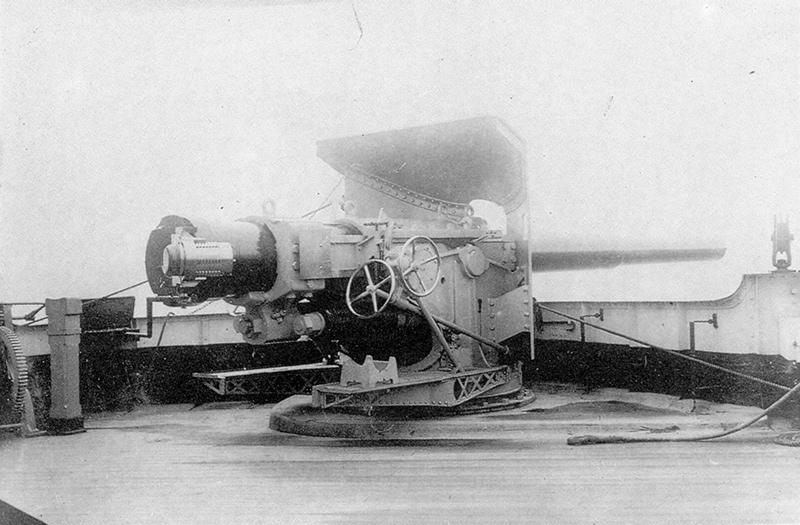
152-mm orudie Kane
housing
The case is assembled on a plaid (a bracket) framing system. K vertical kylyu (the height of the middle part 1844 mm, in the extremities 1100 mm, thickness of 16-11 mm) fastened cast odds- and sternpost. Parallel to the keel has six of bottom stringers, and extremes are watertight and have limited space of the double bottom. iShpangouty installed at a distance 1100 mm apart. At every fifth frames were continuous waterproof flora numbered frames, as is customary in the German Navy, It was carried out from the stern to the nose between 115- 13 nm. double bottom housed in the engine room upper bottom continued along the sides to armored deck, forming longitudinal bulkheads at a distance 575 mm from the outer skin
Along the sides of the middle between the end of the bottom stringers and the lower edge side was armored deck stringer, Connecting to the fore and aft decks with platform. To ensure survivability during combat damage to a body divided by watertight bulkheads on 13 compartments.
The cruiser had three decks and platforms: the top (thickness 9,5 mm in the middle and 7 mm in the extremities), a battery or residential (b mm) and armor. On the decks was nastlan linoleum: at the top - thickness 7 mm, on others - 3,5 mm. Shell plates arranged in longitudinal rows (poyasyamy). Internal keel belt, passing in the middle of the bottom, We had a thickness of 12 mm in the middle portion of the housing and 10 mm in the extremities, side belt – 8 — 11 mm, and zygomatic, shirstrechny and at the waterline - 13 mm. Besides, shirstrechny times higher than the side windows doubled sheet thickness 10 mm.
Throughout the length of the ship at the waterline width placed side cofferdams 0,6 m and a height of at 1,2 m above the load waterline. According to the project, they were filled with maize cellulose and serve as additional protection. anticipated, that the admission of water through small holes pulp swell and block the flow. Experiments with the use of such protection in the navies of other countries have been unsuccessful, and in the course of construction "Askold" MTC decided to leave empty cofferdams. To protect against corrosion, and fouling algae and barnacles, the underwater part of the body was covered with a proprietary paint “Internationalism” (Red) firm “Holzapfel ". Double bottoms inside was covered with a layer thickness of Portland cement 13 – 50 mm. In places, wherein the steel body in contact with copper and its alloys (stern tubes, kingstony), to prevent galvanic corrosion placed protectors - zinc bars. Coal pit located throughout 50 — 97 nm. both under the armored deck, and her, along the boards, and served as additional protection.
booking
The entire length of the ship from stem to stern frame held armor turtleback. Her lower lip in the middle of the hull was on 1400 mm below the waterline. Above the boiler and engine rooms upper edge of the horizontal part located on the armored deck 390 mm above the waterline. Bevels deck formed with its horizontal part of the angle in 37 degrees and passed into it smoothly, with a rounding radius 500 mm. All openings for chimneys and fans have armor grille, coal and neck and triggers armored hatch cover. Armor plate composed of two layers: the bottom of the shipbuilding steel 10 and 15 mm and the top of the nickel alloy into armor 30 and 60 mm. The horizontal portion has a thickness armored deck 40 (10+30). bevels 75 (15+60) and 100(10+30+60) mm.
Grounds for chimneys and ammunition feed silos were covered by an armored deck 40 to the living-mm vertical armor plates. Descent to the steering compartment defended inclined 100mm Surface coaming armored vehicles mine-protected vertical 60 mm armor, and the top and bottom of the 30-mm horizontal decks. Conning tower was 150 mm vertical armor walls and traverse the same thickness, covers the entrance, and the roof and deck - 40 mm. steering actuators, engine telegraph, Interphone pipe, coming out of the conning tower, placed in an armored tube diameter 400 and a thickness 80 mm.
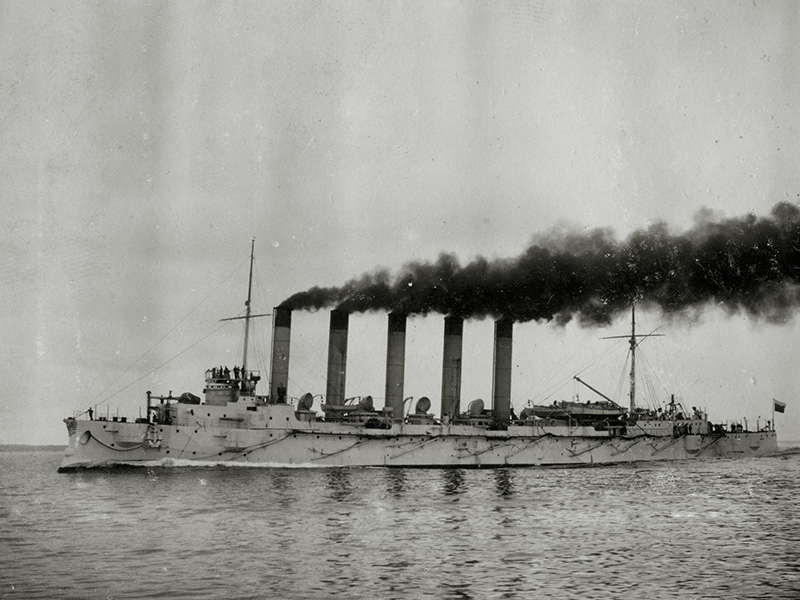
Ship machinery and systems
Machine-boiler system housed in two cars and five boiler rooms. Three main four-cylinder vertical triple expansion steam engines of the company system “Germany” worked each in its own screw. In the front engine room is spreading machines, calling themselves “onboard”. In the back (aft) engine room was machine, worked on the middle screw Right and left screws rotate in the direction of, the same name with a board, The average was left rotation. Each machine had a refrigerator with a cooling surface 1980 m, one high and middle cylinder and 2 low pressure cylinder the cylinder diameter is 930. 1440 and 1630 mm, respectively,, and Stroke 950 mm. Par for machines allowed 9 boilers Tornykrofta-Schulz. 8 of which are housed in pairs in four boiler rooms, a 1 - fifth. The highest allowable pressure steam was 17 kg / cm, the total surface of the grate – 107 m. and the total surface of the heating boiler -5020 m (large boiler – 580 m. small - 480). Weight one boiler water equaled 46.2 t (39 t without water), paroproizvoditelnost- 21,2 t / a, KPD – 60%. coal consumption 1 kg / i.l.s. in time. allowable air pressure forced the - 80 mm water column. To supply water to the boiler in each boiler room were two piston pump system Vira.
For pumping large amounts of water, entering through the hole, It served as a drainage system. On “Askold” it differed from earlier ships built absence of a single main pipe, runs the length of the body. When all the old system dewatering means could pump water from any compartment. However, after several, when the main pipe during navigation accidents damaging (eg, Armadillo accident “Gangut” at 1896 todu, his death in 1897), in the Russian Navy chose autonomization dewatering means of compartments. On “Askold” any of the compartments is drained from the water drainage own means. All boiler rooms and in the fifth and eleventh compartments were Centrifugal dewatering pumps (turbines) electrically driven. In addition to the turbines on the top and the gun decks were four hand pumps Ston.
drainage system intended for the removal of the compartments of a small amount of water, consisting of special piping and steam piston pumps Vortingtoia, the available in each compartment They were able to pump out the remaining water, who could no longer take the turbine drainage system from bilges side compartments and a double bottom. cellars flooding system provided their filling with water for 15 minutes. Water enters the cellar by gravity when unlocking outboard Kingston. Valve rods were removed in-deck and had a screw cap with a lock to prevent unauthorized flooding. piping and valve system is allowed to flood each individually cellar, and the whole group of contiguous cellars. Water is removed from the bleed valves in the double bottom space, and then using the drainage system overboard.
Fire alarm system included a main pipe, extending under the armored deck and uncoupling via klinketov three independent parts. processes pipes, go above the armored deck to fire horns, in the case of combat damage could shut down the special klinketami. The water in the fire mains Vortinpona pumped drainage system, which in this case is used as a bilge pump fire. could be used for fire-fighting purposes and hand pumps Ston. To extinguish fires in coal pits with steam had special steam pipes from the main boilers. To facilitate the entry of people from the engine and boiler rooms for large fires, in the output shafts envisaged shower funnel, creating a water curtain.
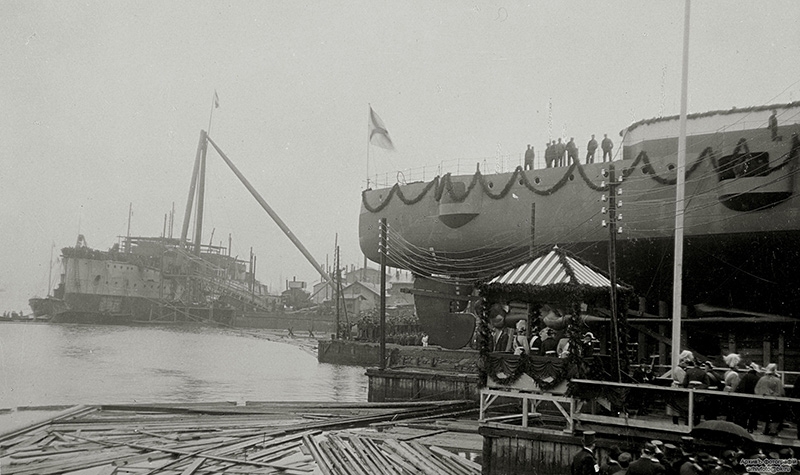
I-protected cruisers rank “Askold” before launching, 2 Martha 1900 of the year
ship water provides several systems: seawater, Fresh of washing and drinking water. seawater system (nautical) water bath supplied with water, latrines, showers in boiler rooms. coastal fresh water system supplying sinks, bath, laundry, infirmary, buffets, galley. System opresnennoy vodы (drinking), received shipboard desalination plant, water was supplied in tanks for drinking, buffets, galleys, etc.. The role of water towers on the cruiser was carried out of the tank, located above the upper deck on add-ins. With pump water pumped into the tank, and then fed by gravity to consumers Fresh node (53 t) stored in a covered space mezhdudonkogo cement tanks and was intended to 17 day. Besides, there was a supply of water for washing of -83 m. Cruiser took the normal stock in 123 t boiler water. When the five boilers was enough for him 10 15 days uelovogohoda. Full supply of boiler water (370 t) could provide swimming for a month. In the aft engine room were two desalination of seawater, Let's day 280 tons of fresh water for boiler and for drinking. Water pipes and tanks of washing, drinking and boiler water does not communicate with each other.
Residential and office space system cruiser warmed low pressure steam heating. The vapor pressure of the main boilers, reduced to two atmospheres, on steam pipes fed into the battery (warmer). Exhaust steam was condensed and the tubes drained into the tank of fresh water. In the officers' cabins, saloons and mess-steam heaters shut marble tops.
The ventilation system in the cruiser was divided into natural and artificial. When the OS design (as well as in the case of drainage and drainage systems) requirement was fulfilled to avoid cutting the main pipe and possibly secondary bulkhead had its fans in each compartment. Particular attention was paid to venting engine and boiler rooms, wherein intolerable heat made unbearable and without heavy lifting and stokers drivers in Kochegarka were two injection Black centrifugal fan drive system with steam. Each engine room ventilated one blower and one exhaust centrifugal fans with electric drive in smokers over boiler compartments used the effect of increasing natural draft ventilation shafts by heating with hot air. Under the nose of armored deck and aft of the engine and boiler rooms ventilation was performed vintopymi electric fans Premises armored deck above have natural ventilation, The exceptions were the clothes dryer, for provisions cellars and premises of small dynamos.
Because, smokeless powder that singled essential gases and decomposed at higher temperature, in artillery cellar is separate ventilation with charge air cooling. The ventilation pipes, leading to the cellar, length prevent lightning, insulators have been installed. Required special attention and periodic ventilation and coal pits, which did not exclude the possibility of spontaneous combustion of coal, emit flammable gases. To control the temperature in all coal pits special temperature tubes were arranged, going from the bottom to the gun-deck th.
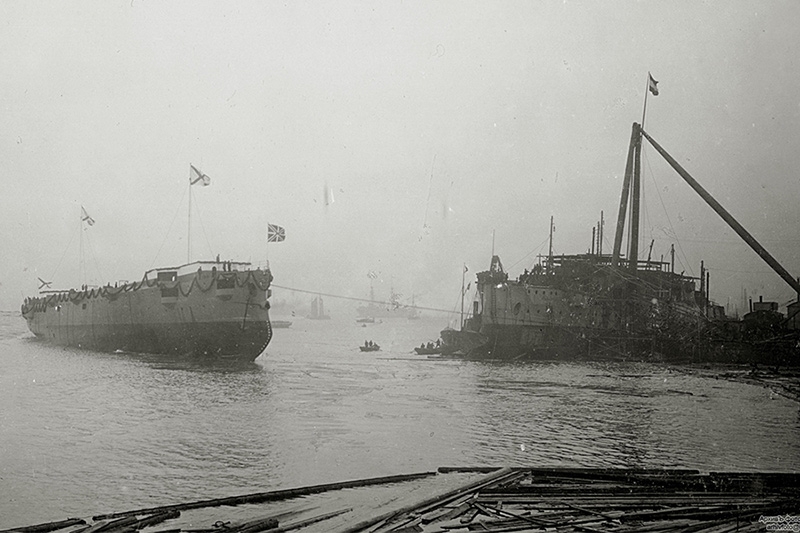
Launching protected cruisers I-rank “Askold”
artillery armament
Upon entry into operation cruiser had twelve 152-mm and 75-mm shells, eight 47-mm and three 37-mm guns, Hotchkiss, two landing 63.5-mm cannon and two machine guns Baranovsky.
152-mm (six-inch) sample instruments 1891 g. were made at the Obukhov factory under license by French engineer and Kane were on the upper deck and the bow superstructure. 75-mm (three-inch) Kane guns sample system 1891 g. Moller placed on the design of installations on the gun deck without shields.
Six 47-mm cannons Hotchkiss of the sample system 1896 g. a stationary, and two - on portable machines -mogli transferred to two steam boats. Similarly, two 37-mm Hotchkiss sample 1V96 g. It can be removed and used on longboats cruiser.
Two 63.5 mm sample guns Baranowski 1882 g. wheeled carriage intended for ship landing. Their light weight allows you to unload them from the cruiser boom on the barge or boat and hand deliver to the shore. They are located on the upper deck - as well as two machine guns Maxim system.
Ammunition for 152-mm guns was calculated on 3 hours paint 180 rounds per gun, to 75 mm – on 2.5 hours paint 650 shots. Ammunition of the main battery consisted of 564 armor, 564 explosive, 624 cast iron, 372 segmental shells, and 75 mm: 1500 armor and 2116 cast iron. After the Russian-Japanese War and the iron segment explosive shells replaced.
Artillery ammunition was stored in 12 funeral (six of them were designed for 152-mm, three for the 75-mm and three for small caliber artillery). Total capacity: 2204 – 152-mm, 3616 – 75-mm, 5990 – 47-mm, 1620 -37-mm rounds.
feed shells, charges and unitary cartridges from the cellars was carried out 14 electric elevators (eight for the main battery and three for 75-mm guns and small-caliber) or backup method - manual winch. In the event of failure envisaged manual feed using hoists, but elevators feedrate was three times higher. Ammunition was stored in cellars and fed to the deck in the gazebo. From the elevators to the guns gazebo by rail sailors pulled apart by hand. Storage ammunition in pavilions ensured high feed rate, but shortened the useful volume of the cellars. Special devices for loading ammunition on the ship was not, they were either loaded manually by ladders from a barge or from the wall, or through the open ports of 75-mm guns.
On fly bridge and aft superstructure placed two rangefinder Barr and Stroud. artillery fire management from the conning tower provides an electrical system firm N.K.Geyslera. Given the angle of fire guns and the most advantageous location for booking artillery battle cruisers were of course angles 45 to 60 degrees both sides. During the ship service time artillery armament changed: in the besieged Port Arthur, two 75-mm were left, two 47-mm guns, machine guns and two guns Baranovsky. Subsequently, two-port 75-mm guns patched. During the First World War, two 47-mm removed and installed by two 57 British and two 47-mm anti-aircraft guns of French and four machine guns.
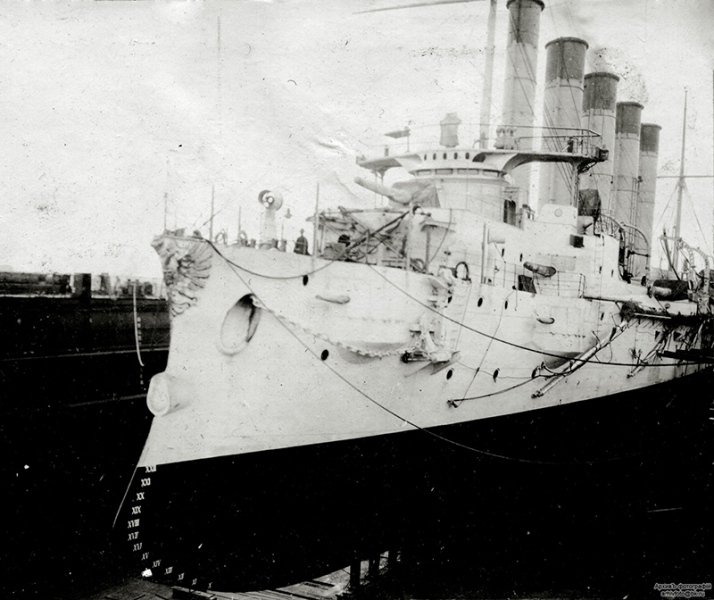
I-protected cruisers rank “Askold” in the company's floating dock “Blom und Foss” in Hamburg, 1901 year”
mine armament
The cruiser had six mine devices caliber 381 mm for firing mines Whitehead. On the gun deck at the centreline located fore and aft vehicles with aerial gunnery system. Of the four on-board units, two subsea systems Armstrong had air, and two surface Putilov plant – powder fire system. Nasal, Stern and underwater TA were fixed, Side surface can rotate within the apple hinge 45 ° ahead of and 35 ° abaft the beam. The conning tower had sights for each device, team for a shot transmit electrical pointers. Besides, Every machine is supplied with reticle port with mine eye, Allows you to shooting self.
Stored on board 14 min Whitehead, 12 - the machines with rotary racks, and two spare for underwater vehicles in the aft compartment mine.
There were two removable device and throwing mines for steam boats weapons. Cylinders min and apparatuses for aerial gunnery system filled with compressed air via three pumps (compressors) Schwarzkopf, is below the armored deck. To recharge the device needed 10 minutes. After the Russian-Japanese war machines dismantled side surface.
In a special mine-cellar in the stern of the stored 35 min sample barrage 1898 g. For their performances on board a mine placed a collapsible raft. Mines have been removed from the cruiser back in Port Arthur.
For protection against self-propelled mines (torpedo) "Askol'd" had a removable barrier network, consisting of steel is fastened to the board, steel chains and accessories. When setting the poles were installed perpendicular to the board, releasable braces and their ends suspended from network. Her twenty panels measuring 7.6×6 m consisted of woven metal rings with a diameter 152 mm. In its stowed position alongside the releasable poles, and minimized network were placed on the ass.
To mine armament concerned and all electrical equipment. Cruiser source of electricity were six steam dynamos "Siemens and Halske" total capacity 336 kW. Four of them, capacity of 67 kW, located under the armored deck, and two (by 34 kW) – in a separate control room on the deck.
Mast electrical DC voltage network 105 In consisted of three ring roads - for the supply of electric motors, lighting and floodlights. Electricity consumers were hoist elevators, dewatering pumps, 723 light bulbs, engine and steering telegraphs, minefields and artillery pointers, steering position indicators, phones, calls, bells loud fight. Mangin six spotlights with the mirror diameter 75 cm with manual and remote control of electric.
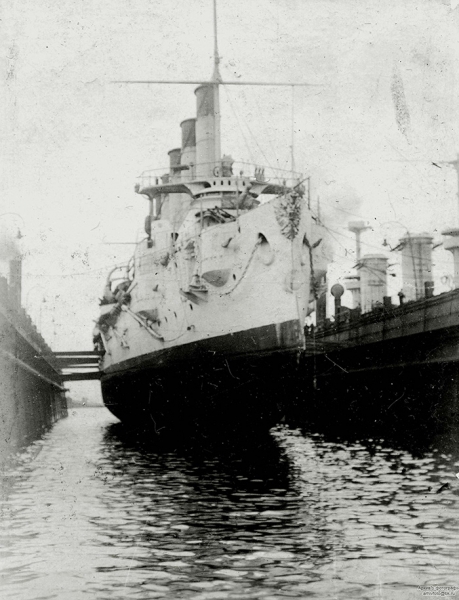
Korabelnыe Device
Steering gear. Handlebars on "Askold" were balance type, frame of each wheel was made of cast steel, sheathed steel sheets of a thickness 8 mm and filled with stopper. Ferries steering gear allowed in full swing shift steering wheel from side to side for 30 from. Control spool steering gear was carried out with four posts, had steering wheels with hydraulic and electric drive: in combat, in the way and feed logging and in the steering gear compartment. When the steam engine malfunction steering translated pas handwheel in the steering gear compartment.
Anchoring apparatus consisted of two anchors becomes Hall with retractable rods, two cut-beams, nasal hawse Baxter systems and two spare anchors on deck. Baja located on steam spire with two vertical rolls chain with one double ropes and mooring ropes for drum. On fantail set small for mooring vapor spire.
boats
In addition to standard wooden Yalov and whaleboats, cruiser carrying two steam steel cutters, working boat, pinnace and motorboat. Steam boats with a displacement of 12.25 so we were able to complete the course 9,35 node pass 180 miles and armed with 47-mm gun Hotchkiss on his nose and a machine gun "Maxim" in the stern. Instead of throwing implements mine machine can be installed. Work boat has been adapted to transport tools landing Baranowski, a two armed pinnace 37mm guns Hotchkiss. For laying mines had mine collapsible raft sample of the Black Sea Fleet, raises six minutes. At its assembly and launching required 20 minutes and ten minutes to load.
Crew
Upon entry into operation of the box looked like a cruiser: 21 Officer, 9 conductors, 550 the lower ranks (non-commissioned officers, sailors). During the First World War: 19 officers, 11 conductors, 620 the lower ranks.
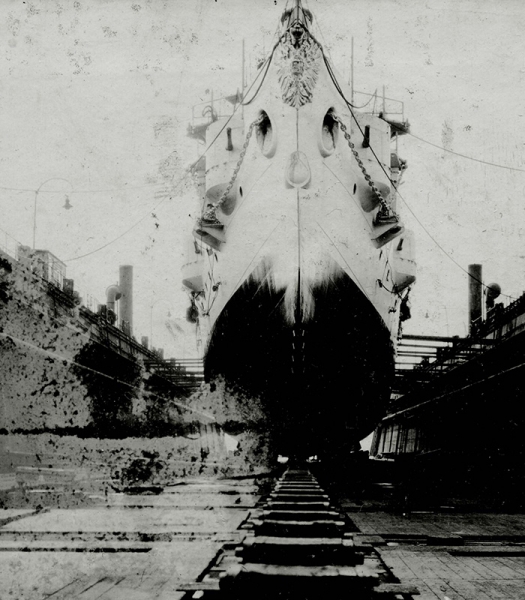
Overall evaluation of the project
Advantages and disadvantages of distant reconnaissance program 1898 year largely determined by "design program”, than project developers, associated stringent requirements main drawback “Askold” and his brothers had no armor belt at the waterline. The experience of the Russian-Japanese war revealed, that the coal pit and side cofferdams can not serve as sufficient protection from falling into the area of the waterline caliber shells from 152 mm and more. Even if the bevel armored deck remained intact, water through the neck explosion deformed, apertures or knocked loose rivets, open seams decks and bulkheads flooded several board offices and gradually filtered into neighboring. holes, received "Askold" and "Diana" at the waterline in battle 28 July 1904 of the year, It was the main reason for their internment in Shanghai and Saigon. After the war, the very idea of protection of vital parts cruisers only karapasnoy armored deck, instead of the belt armor was criticized. So, teacher Naval Academy N.L.Klado wrote: “As to the large protected cruisers, the futility of their no doubt, yes it not worth spreading, since it was decided long before the war in all fleets, with the exception of, Unfortunately, Russian”. This opinion is shared by the captain 1 rank L.F.Dobrotvorsky, commanded the cruiser “Oleg” in the Battle of Tsushima. Really, Germany is not reproduced in its fleet or "Askold", us “hero”, continuing to build the well-protected armored cruisers with strong artillery and small cruisers with 105mm artillery displacement of about 3000t. Also in the US Navy is not attracted by the project "Varyag". However, it should be remembered, what, determining future basic elements cruisers, ITC experts proceeded from the, that the long-range reconnaissance should be stronger and Fleet Japanese cruisers "Takasago" and English like "Arrogant". That is not to target the fight with armored cruisers, away from them because of the speed advantage. Then compare with the modern protected cruisers of similar displacement will be in favor of the "Askold". The main opponents of the cruiser "Takasago", "Chitose", “Kasagi”, “Iosino” on tests developed a rather high speed - up to 23 knots, but at minimum load and a significant boosting of boilers. Russian ships have been tested under more severe conditions, which could give the difference in the two nodes. On "Askold" the power of artillery fire was superior to those of rivals, and even more protected cruisers smaller displacement («Otova». "Niytaka" "Tsushima") The English cruiser Heep "Hermes", is the development and continuation of the "Arrogant", entered a system and 1900 year (displacement 5600 t, speed - 20 — 21 node, armament - 11 - 152 mm, 9 - 76 mm. 6 - 47-mm guns and 2 torpedo tubes). Two more of the same cruiser - "Challenger" and "Encounter" were launched in the Linear Ordinary Differential Equations 1902 year and put into operation in 1905. Furthermore, in England, in parallel to build large protected cruisers in 11 000 ie types "Dayadem" and "Argonauta" with 16 152-mm, 14 76-mm guns and speed 20- 21 node. In France 1901 was protected cruisers “Satori "developed 24 node with a displacement of about 8000 t. but he yielded to our cruisers in service with, having 2 165-mm, 6 140-mm 10 47-mm guns. The same weapons had entered into service one year later "Guichen", develop during the 4-hour test average speed 23,55 host. Next "Edmond Jurien de La Gravière" in displacement 5685 ie arming 8 165-mm 10 47-mm guns, I had a speed of more 21 host. In this way, in assessing Klado large protected cruisers contain inaccuracies: they were built in a major maritime power. And when comparing the "Askold" with his contemporary protected cruisers can reasonably conclude, he surpassed them on most items.
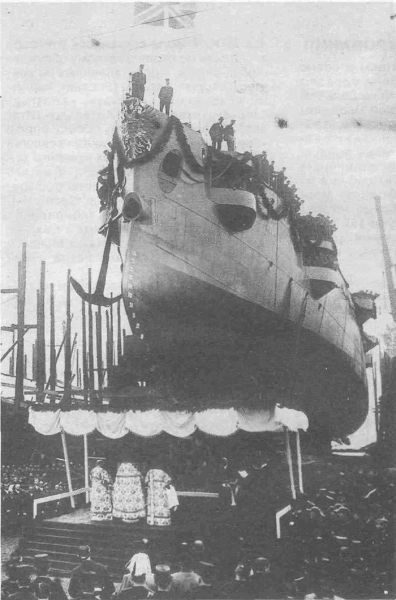
Prayer service before launching cruiser "Askold"
Now, compare the "Askold" with built one on him the task of "Varyag" and "Hercules" Fastest entered the system "Varyag", but it was also the most expensive: its total cost, along with weapons and ammunition -6 million. rub., "Askold" – 5 million , -“warrior” – 5,5 million. As part of the terms "design program less well decide the problem of protecting artillery Americans to" Varyag ", wherein 152mm gun do not have shields. The most secure was the artillery of "Bogatyr": 4 152-mm guns – towers, as many – in dungeons, and only further 4 in deck installations. However, from the point of view of fire control best layout tools different “Askold”. His 152 mm cannon positioned on the upper deck, and 75 mm - below deck. In the "Hercules" is 152 mm and 75 mm gun in the middle portion were mixed, making it difficult to control fire. The "Heroes" in the broadside could participate eight guns of the main fire, the "Askold" -sem, the "Varyag" six. But due to the fact, that the rate of tower of "Bogatyr" guns was twice below deck installations, "Askold" actually led weight volley.
Projecting the "Askold" firm "Germany" experts, fear of failure rate at working conditions, too Sause body and tried as much as possible to lighten the ship. According to the requirements of the MTC Commission and observe in the course of construction, some structures have been strengthened, performed additional reinforcements, resulting in body weight was on 83 tons more, e than the original draft. During the operation, "the ease of construction" made itself felt vibration and, as they said, the, that the body "breathe" on the big move. AT 1903 It was in the stern, two burst flora and had to perform additional reinforcements. builders haste deprived "Askold" forecastle, which offered the shipbuilding department MTC, and hence in the oncoming ocean wave it bury nose in water.
Under the terms of habitability "Askold" was different from his contemporaries for the worse (I had narrow passages, less convenient Kubrick). But the design and manufacturing quality mechanical installation cruiser were higher praiseworthy. Boilers and machines have proven to be reliable and very economical. As proof you can give at least the fact, What's on 18 500 miles, proydennыh "Askold" in 1902 year, It has been spent 7300 tons of coal, while the "Varyag" on the way in 8000 miles required 8000 t! Looking ahead, remark, that it was due to the excellent machine installation "Askold" was able to make his famous breakthrough in the battle 28 July 1904 of the year.
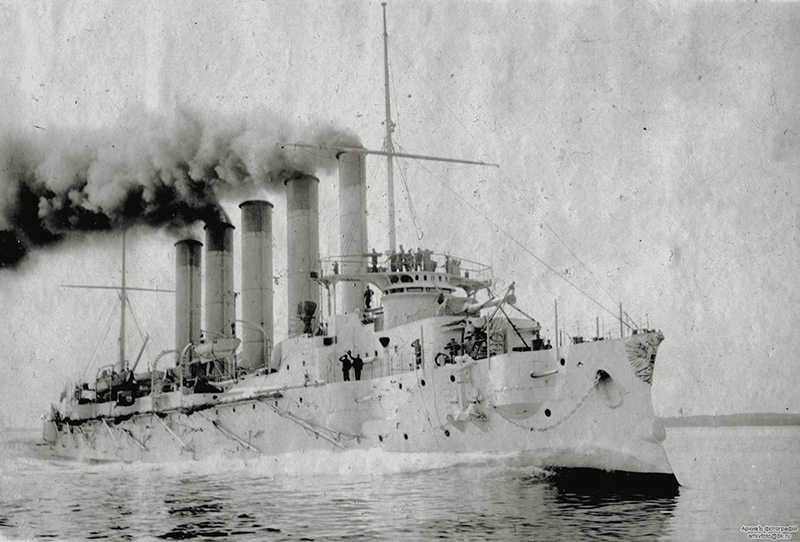
Cruiser "Askold" sea trials
In the campaigns and battles
27 January 1902 the cruiser left the Kiel Bay and two days later entered the Emperor Alexander outport port 3 (Liʙavu), which stood until 1 May, and then he joined the detachment of warships under the command of Rear Admiral GP Chukhnin, who was walking with the Far East in Kronstadt. During the summer in the "Askold" held progressive tests, shooting mine vehicles, We established a number of mechanisms, instruments and devices, including wireless telegraph station.
Having taken full ammunition and supplies, 3 September "Askold" forever left Kronstadt and went to the Far East to reinforce the Pacific squadron. At the transition studied agility and driving performance cruiser, determines the optimal operation of boilers and main engines, At the beginning of the transition to board the ship for the study of deformation structures housing on the ocean waves was a famous shipbuilder, future academician Krylov.
Along the way, performing a number of diplomatic missions in the ports of the Persian Gulf. "Askold" 13 February 1903 year stood at anchor in the roads of Port Arthur. Difficult passage on the seas of three oceans finished brilliantly.
Thanks to the successful design, high manufacturing quality and sound operation of the cruiser of the machine worked perfectly. Immediately after going to the control output with overgrown in the tropical seas of underwater part of the "Askold" easy to develop contact and power on a large wave showed speed in excess of 20 knots. Well established and 9 double boilers T.Shultsa design. They proved to be reliable and economical boiler most other systems, installed on cruisers of the Russian fleet.
In accordance with the sailing ships of the squadron "Askold" in 1903 year ought to be an armed reserve five months and spend the winter in Vladivostok. But the situation in the Far East grew tense, Japan's preparations for war became more and more apparent, as well as the superiority of its fleet.
While in the Ministry of the Navy tried to speed up the completion of and sending in the East Ship Programs 1898 of the year, Russian Foreign Ministry has attempted to ease tensions through diplomatic efforts. At the request of the ministry in order envoy to Japan A P.Izvolskogo was isolated "Askold".
As part of this “diplomatic” expedition cruiser visited Nagasaki, Iokogame, What, I visited the Chinese port of Taku, English colony in China - Veyhaypey and German - Qingdao 30 April 1903 he returned to Port Arthur.
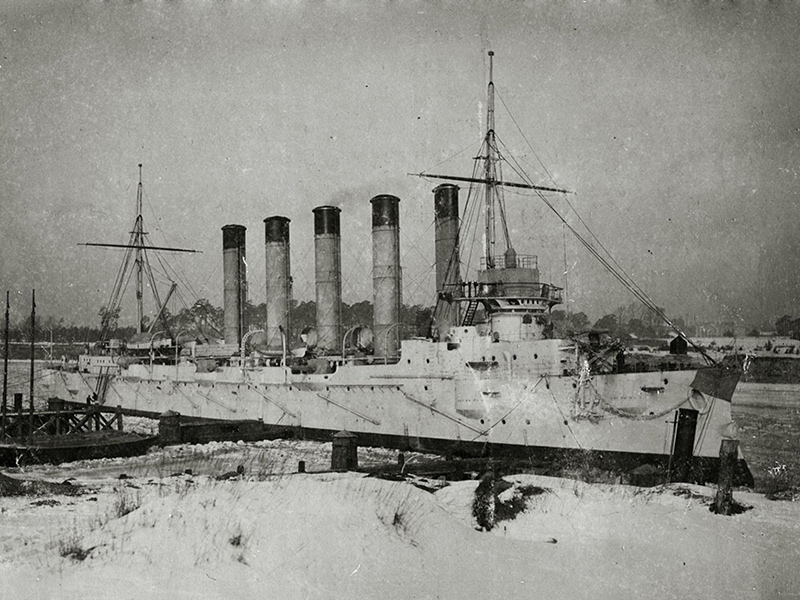
I-protected cruisers rank “Askold” after installing the flying bridge. Autumn 1901 of the year
But already 3 May "Askold", together with the cruiser "Novik" again went to sea. Their route was in Vladivostok for the meeting of Minister of War, General of Infantry A.N.Kuropatkina. With the "Askold" the minister inspected the bay of Primorye and 28 May arrived n the Japanese port of Shimonoseki. where, together with his entourage left the train in Tokyo, and "Askold" and "Novih" moved to Kobe with the arrival to the diplomatic mission of the campaign continued. visiting Nagasaki, cruiser headed to Port Arthur, where they arrived safely 17 June thunderous salutes and orchestra.
In Port Arthur Kuropatkin looked to strengthen the fortress, garrison troops, She visited by the ships of the squadron, and held a number of meetings with the local commanders of the Defense of Port Arthur and the Far East. Upon his return to St. Petersburg, he thanked the manager of the Navy Department, Vice-Admiral F.K.Avelana for providing cruiser, and he added: "I consider it a pleasant duty to testify about the cordial solicitude, I and my companions were rounded up during the voyage ".
In Port Arthur, the crew finally got a rest after a busy, especially for the engine-room, navigation. During the "diplomatic" hiking "Askold" confirmed the reputation of the best cruiser squadron: machinery and boilers worked flawlessly. Tense ship service was an important test of all the mechanisms and parts, showed good quality of design and construction, a high level of maintenance.
Month cruiser was in the armed reserve, but 31 July again entered the campaign. Viceroy in the Far East, Vice Admiral E.I.Alekseevu urgently needed to follow to Vladivostok to address the issues of preparation to the defense of the Primorsky Territory. The transition went perfectly. Vice Admiral Alekseev, thank the team for excellent service, I went ashore. On "Askold" is strongly engaged in combat training.
19 of August in the Gulf of Peter the Great cruiser carried out target practice on the shield on the speed 18 nodes at a wind 3 -4 points. Although visibility was unimportant (temporary shield hiding in the fog), gunners "Askold" performed well: of 36 issued 152 mm projectiles at a target hit 7, of 36 75-mm -12 and from 40 47-mm 5. It is interesting to compare these figures with the results of a similar shooting "Varyag", made them 16dekabrya 1903 of the year (last teachings before his famous fight) Although the "Varyag" was shooting, going at a slower speed (12,5 host), of the same 36 issued 152mm shells. 33 75-mm, 56 47-mm 20 37-mm board got all the three: one 75-mm and two 47 mm.
23 August, the detachment under the command of Rear Admiral E.A.Shtakelberga "Askold" with the cruiser "Russia". «Gromoboй», "Bogatyr" weighed anchor and went camping by the Sea of Japan with a visit to the port of Hakodate in Hokkaido. After returning and weekly parking space in Vladivostok.
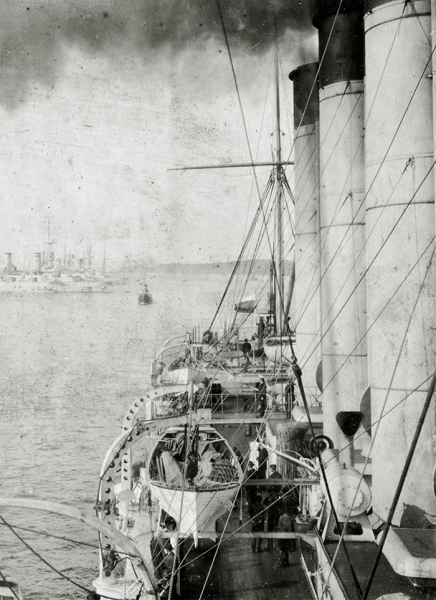
I-protected cruisers rank “Askold” in Kiel Bay, 1901 year. On the stern flagstaff Cruiser – national flag of Russia, tk. the ship has not yet officially joined the fleet operation.
“Askold " 10 September came out again and the sea, this time in the squadron of 6 bronenostsev and 5 cruisers. Going to Port Arthur it was combined with maneuvers, with the participation of the Army of the Kwantung Peninsula and Port Arthur fortress.
The final important for "Askold" change of command was the event of peacetime. 17 January 1904 year appointed head of group of cruisers H K.Reytsenshteyn (instead of sick E.A.Shtakelberga) I passed the ship captain 1 rank K.A.Grammatchikovu, former commander of the 2nd Detachment destroyers. Meanwhile, Russia's relations with its eastern neighbor with each passing day more and more sharpened. And the denouement was swift…
in the evening 26 January 1904 , Japanese destroyers without declaring war attacked the Russian squadron in the outer harbor of Port Arthur. For the destroyers immediately fired back, but three torpedoes still amazed battleships "Crown Prince" and "Retvizan" and the cruiser "Pallada".
"Askold" was standing in the first line and its location is closest to the danger. But thanks to the precise actions of staff he was able to avoid getting. Strong return fire prevented the enemy as it should aim, although two torpedoes passed dangerously close to the stern of the cruiser.
morning 27 January the main forces of the Japanese fleet under the flag of Commander Admiral H.Togo came to Port Arthur and clashed with standing on the raid ships and coastal batteries of the fortress. Russian cruisers were close to the enemy, Cem bronenostsы. The first 12-inch shell fell between “Askold "and" Bayan ", holding up a huge column of water. «Rich», "Askold" and "Novik" were between columns battleships, but turn aside from the battle, and boldly go on the attack.
Forward-speed burst is the "Novik", I am trying to get closer to the distance of a torpedo shot, We rushed him "Bayan" and "Askold", continuously firing all guns. The Japanese moved their fire on the three cruisers. To avoid getting, "Askold" was going zigzag, but still a few enemy shells, and many pieces have reached the chain.
On "Askold" dismantled signal flagship: "Cruisers not to interfere with battleships", - Captain 1 Grammatchikov rank ordered to turn back. Cruisers came out of the fire. However, their risky attack played an important role. They distract the enemy at the moment, when our battleships had not yet formed a battle line. Together with the fire of the shore batteries and battleships of Admiral Togo Activity forced to cease artillery duel and leave the area of Port Arthur.
The "Askold" for 40 minutes of battle got six rounds and a large number of fragments from close gaps. Four gunner killed, 10 sailors were injured.
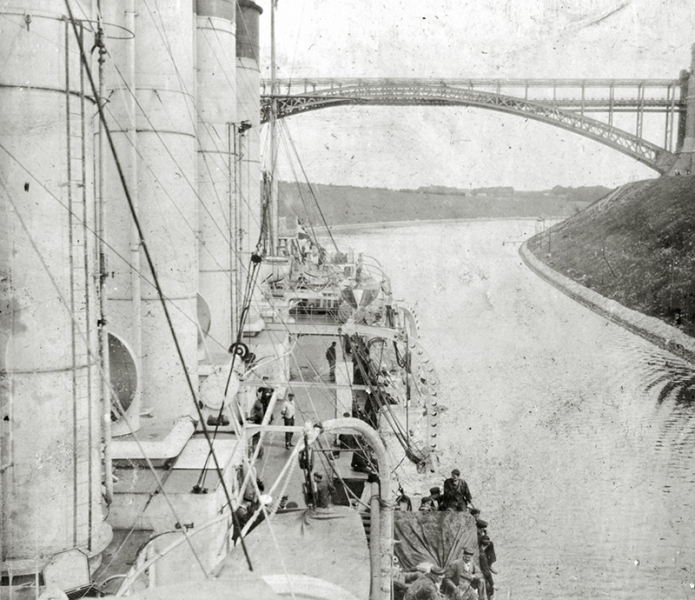
I-protected cruisers rank “Askold” Kiel in channel, June 1901 of the year
The heaviest damage inflicted large shell, caught in the left side at the waterline near the 53rd frame and ripped in cofferdam. Shrapnel pierced the inner longitudinal bulkhead, water began to come into being for her coal pit. Fortunately, the hole was completely filled with coal, Zadran and neck, so that the ship does not even received bank. Besides, explosion smote two frame, a hole formed in the outside plating area 0.9 m. Fragments of the projectile damaged the 75-mm gun and struck the battery compartment mines Whitehead, is in the machine and finally prepared to fire. Incandescent fragments went near the capsule with mercury fulminate, not calling, Fortunately, ignition or detonation of the explosive. After this incident, the team believed in the, that "Askold" - a happy ship. As soon as the cruiser came out from under fire, overboard devices to surface ships lowered miner, which is unscrewed from torpedoes drummers.
Another shell tore a barrel in 152-mm guns on the starboard side. Another one, large caliber, He ranked fifth in the smokestack and exploded, seriously damaging it. The fourth chart-room destroyed, fifth shot down the main-mast, sixth shot and injured aboard the wardroom.
Armadillos after a fight had taken refuge in the harbor, "Askold" the same with the other cruisers carrying on patrol duty on the roads. For three days it had under steam boilers, and the team was in a constant voltage. And only then the ship put to the wall of the Marine plant for the repair of damage. By order of the governor Alekseeva 24 "Lower tier" "Askold" were awarded marks of distinction of the military order of St.. George.
After completion of repairs, "Askold" 5 and 9 February went out to explore the area adjacent to the fortress, a 11 together with the cruiser "Bayan" and "Novik" was involved in a shootout with four Japanese cruisers.
morning 12 February the main forces of the Japanese fleet came back to Port Arthur. «Rich», "Askold" and "Novik" were on the outer roads, covering returning to sea destroyer.
Six battleships and six armored cruisers of the Japanese opened fire. Our cruisers immediately responded. "Askold" at this moment was the closest to the enemy. We give eyewitnesses: "They showered us projectiles, boiling water, here, there rose large columns of water, shells exploded, showering shrapnel around. Here's one for the other 2 projectile falling astern, wherein one so close, that pours water on the poop deck. At this time, a shot rings out the aft gun, as if in response to the fairing flown. Dials continually call, showing the distance: 45. 45 1/4. 43… 35; shells fall closer and closer, but we make progress and our car, We always come to the rescue, It brings us out of danger, shells fall astern, with boards or ricochet to the beach. We shot continuously, rushing to the raid in full swing ". After the first shot on - "Askold" severed trunk 152 mm cannon, fragments rained down on the deck. The distance between the two vehicles and reduced to the Japanese 32 cables. Only big move saved "Askold" from deadly for it hits heavy shells. Unique three battle cruisers against 12 armored ships lasted about 30 minutes "Askold" released at the enemy 257 shells, not received thus serious damage.
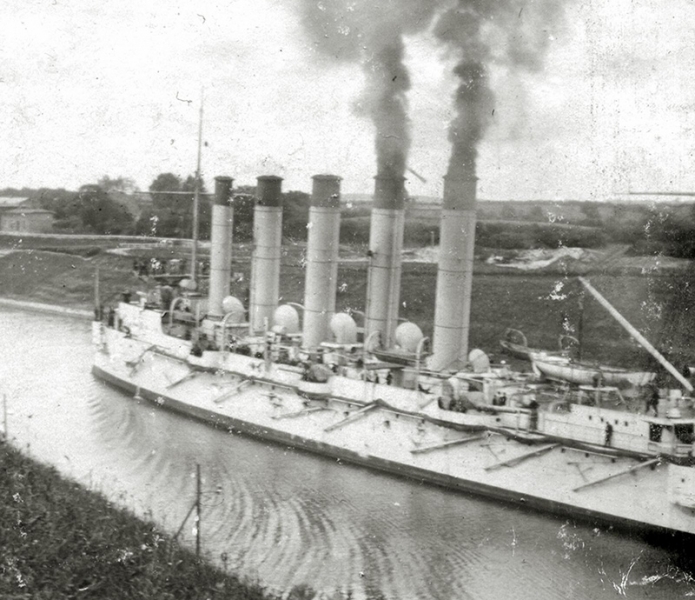
I-protected cruisers rank “Askold” Kiel in channel
24 February Port Arthur arrived new commander – Vice Admiral S.O.Makarov, and our fleet activity has increased markedly. "Askold" in the squadron went to sea 27 February. 9 and 13 Martha, and 9 March - under the banner of Makarova. Upon returning from the last hike back to the cruiser arrived captain 1 Nikolai Reitsenstein rank - this time as the head of group of cruisers. Since then, his broad pennant with the "Askold" almost did not go down. 30 March cruiser went into the juice of which appeared on the horizon of a Chinese junk and brought her to Port Arthur. In the evening on "Askold" Makarov arrived.
Unsuspected, that carried out for the night will be for the cruiser Admiral last. morning 31 March Stepan Osipovich switched to squadron battleship “Petropavlovsk”. On that fateful day for the Russian Navy Admiral he was killed along with his flagship, was blown up by an enemy mine… In April “Askold” in the sea did not come out, personnel involved in coastal batteries armed, askoldovtsы installed parodynamo machine, boiler and a spotlight to illuminate the front of the land defense of the fortress. Alternating № 1 they have four 75-mm guns and assisted in the installation were installed two 75-mm guns with “victory” to strengthen the number 2 and two 75 mm “CESAREVIC” at Kurgan battery on "Askold" and cleaned leached boilers, Miners have touched some mechanisms under the leadership of Lieutenant Keith Keane blasted mast flooded fireships, We checked all the mines Whitehead. By order of the governor with a squadron of ships removed 16 guns, them armed with a newly formed naval machine gun battery Two guns and surrendered “Askold”. Instead ordered guns in St. Petersburg, but before the end of the war they have not received.
5 May “Askold” I went to sea, covering torpedo boat tender "Amur". When you return to the road of the blind the sun's rays from the cruiser did not see the buoys serf minefield. The ship passed through a minefield and, apparently, injured 2-3 mines. Although the passage of time the ships miners land company off the current, swimming on the mines can not be considered safe. But fate and here favored the "Askold".
During a fierce battle in the Kind-zhouskom (Tszinchzhouskom) peresheyhe Russian troops from the flank supported by steam boats to battleships “Retvizan”, “Sevastopol” and cruiser “Askold”. Boats were armed with machine guns and small-caliber pushhi. Askoldovskym komandoval michman F.F.Herken. 13 May, he successfully led the fire on the Japanese army of 47-mm guns. After the retreat of Russian troops blew up the boat, and his team came on foot to Port Arthur.
After he was left Kindzhou, from “Askold” They had been brought ashore two platoons of troops, and two days later Grammatchikov was ordered to remove the 152-mm gun number 5 and 6 and send them to the battleship "Retvizan", and to take steps to increase the angle of fire guns № 7 and 8. 10 June squadron put to sea for a breakthrough in Vladivostok, but, encountering superior forces of the Japanese fleet, turned back. Russian ships have come to raid, when it was already dark and there our cruiser, marching at the end of the wake column, We attacked the enemy destroyers. On “Askold” their first noticed and opened fire. These attacks continued until 4 am.
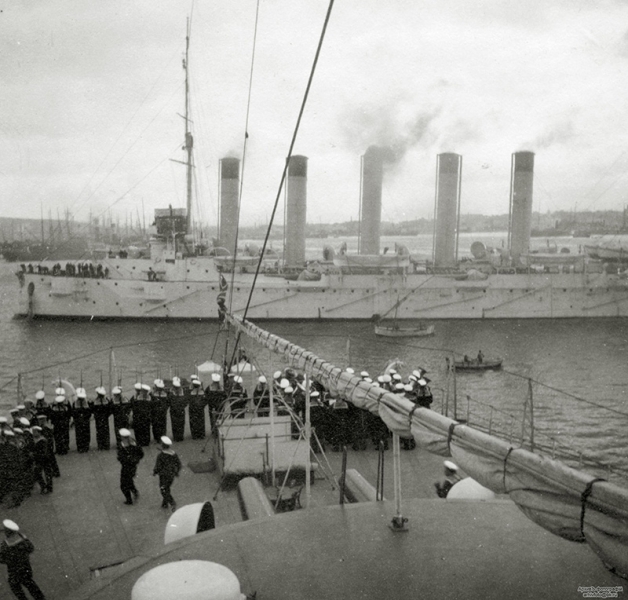
I-protected cruisers rank “Askold” on the Baltic Sea
when dawn, is seen from ships, that floats on the roads about a dozen minutes Whitehead. According to reports from our cruisers should, several destroyers were sunk, However, the Japanese, these data do not support, recognizing a heavy damage destroyer “Cidori”. According to a report Chief cruisers unit at a fraction of the cruiser "Askold" and "Novik" fell the largest number of attacks, they were all reflected sustained aimed fire… Attestation by the commanders of the entire staff with full composure and zeal did my duty ",- the document says of that time.
23 and 24 June was on duty in the passage on the inner harbor "Askold" opened fire on the approaching Japanese ships. According to a report of Admiral Togo, it was used Detachment destroyers. Snaryadami with "Askolyda" of destroyers № 53 and 59 Two non-commissioned officers were seriously injured. Over the next two weeks, "Askold" repeatedly went to sea, shelled Japanese land position, He waged a duel at long distances from enemy ships.
14 July Russian ships again opened fire on the Japanese. About 13 noon approached enemy destroyers, but they were promptly detected signalmen "Askold", seven six-inch shells of the cruiser was enough, to destroyers cleared, but they were replaced by armored cruisers "Nisshin" and "Kasuga" and opened fire with their guns, superior in artillery range of a "Askold". Fragments from exploding near a Japanese shell slightly damaged chimney. AT 15 hours astern "Askold" the Japanese discovered the mine and shot her. Walked the trail "Bayan" was blown up by a mine other. The only armored cruiser squadron, the flagship of the group of cruisers left permanently damaged. His place was taken by "Askold".
28 July 1904 year Port Arthurian saga neared its climax.
The squadron put to sea for a breakthrough in Vladivostok “Askold” under the flag of Rear-Admiral Nikolai Reitsenstein cruisers headed squad, walked in wake column for armadillo 12 30 the battle began. AT 13.09 12-inch shell (predpolozhitelyno with armadillos “Sikisima”) burst at the base of the first tube. Despite, that the lower part of the casing has been flattened, she miraculously remained standing on the spot. Shards disabled the first boiler. The blast destroyed the cabin wireless telegraphy, ladders on nasal bridge superstructure and an upper, mortally wounded stood at the bow rangefinder Rklitsky warrant officer and electrician Zhdanovicha, miner killed Nesterov. In reply “Askold” He fired from a 152 mm artillery starboard, but the distance to the battleships was great, why did only four shots.
AT 13.12 the second largest shell hit aft and exploded in the cabin of a senior navigator. Emerged fire was quickly extinguished. Three minutes later, he turned away to the left. Behind him came out from under the rest of the cruisers shelling: “Novik”, “Pallas”, “Diana”. Seidel bronenostsы, they amounted to a second column. “Askold” I went to the left abeam flagship battleship “CESAREVIC”. The squadron went on kontrkursah, ships and got some respite. AT 16.05 He was received semaphore squadron commander: -In the case of the head of the battle group of cruisers to act usmotreniyu-. AT 16 50 Japanese ships caught up with the squadron of Rear Admiral VK Vitgeft, and the battle resumed with renewed vigor.
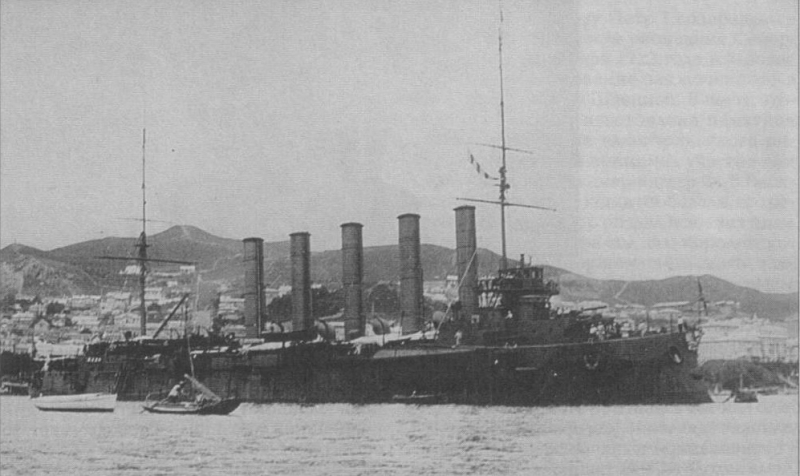
Cruiser "Askold" on the roads of Vladivostok
After a half hour of the battle commander of the Russian squadron VK Vitgeft was killed. At the flagship “CESAREVIC” jammed wheel, and he began to make the circulation of the left. Our system bronenostsev narushilsya, their situation became threatening.
detachment of cruisers, following the movement's flagship battleship napranleniyu, sequentially started turn left. When in the conning tower “Askold” understood, what “CESAREVIC” corrupted, We turned right and went to the course, Parallel lines armadillo. At that time, Japanese 1 -Tactical squad beat Russian head of the column, our cruisers were in range guns head of the Japanese battleships. From the west came closer 5th combat unit (“Chin-Yen”, “macula”, "Itsukushima" and "Hasidim"). 6-and («Sum», Axasi '. “Akicusima”, Ideumi '), bronenosnыy kreyser “asama” and minonostsы. The total number of enemy ships, observed at seven o'clock in the evening, recorded in the logbook figure 45.
Russian battleships turned in the direction of Port Arthur. "Askold", and behind it all the cruisers and destroyers initially followed their example, but soon decides Nikolai Reitsenstein, supported are next in the conning tower and commanding officers,-go for a breakthrough, taking on enemy fire, not stopping at the risk of death. On foremast "Askolda" soared up signal flags: "Cruiser follow me". Of the four undamaged pipe cruiser saw thick clouds of smoke, acute stem foamed water. The remaining cruisers have also increased stroke.
AT 18.50 "Askold" opened fire and went straight to the armored cruiser "Asama", walked alone. Soon Asama "a fire broke out, whereby the Japanese cruiser "increased speed and moved away" – vahtennom as recorded in the journal "Askold". Evaluating the enemy's position, Nikolai Reitsenstein considered the weakest of its location south-west direction, where there were cruisers 3rd combat unit. Beating on the starboard side Russian battleships, system which by that time was like a double edge, "Askold" turned sharply to the left, crossing their course. Skip to their battleships and pass them astern was impossible - the cruiser would have substituted itself under the guns of the main unit of Admiral Togo.
"Askold" developed a full stroke and, broke up with armadillos, headed south. It was followed by the cruiser detachment, but “Diana” and “Pallas” right behind, and only the "Novik" was held in the wake of. Armadillo is still going in the direction of Port Arthur, and soon disappeared from sight. After some confusion the enemy rushed to intercept the "Japanese, apparently, We did not expect such a maneuver, and he immediately diverted a decent part of the fire from the battleships on "Askold",- subsequently wrote Nikolai Reitsenstein.
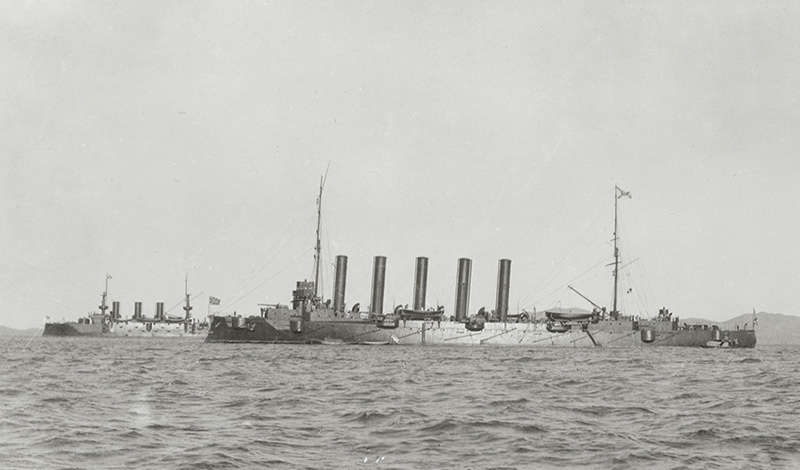
Cruiser "Askold" on the roads in Port Arthur 1904 (on the background – armadillo “Relight”)
Armored cruiser "Yakumo" rushed to “Askold”, leading fire on 203-mm and 152-mm shells. Behind him shone flashes of shots cruisers 6th Detachment, also blocks the way our ships. Left and rear set off in pursuit of the cruiser 3rd Detachment Rear Admiral Virgo. End ship 1 st Combat Detachment "Nisshin" and ships of the 5th squad also suffered a fire on “Askold”. Showered from all sides shells, cruiser posted, leading the fight on both beads, on the nose and aft. Dozens of shells fell around the cruiser, uplifting high columns of water and dousing his barrage of debris. High speed, agility and accuracy to return fire due to the fact, cruiser that survived the monstrous hurricane of fire. But from time to time his body shuddered from the shells hit. Concussion when it was so great, that gauges bouncing arrow, burst light bulbs. The conning tower reported, that water enters into the left aft engine pantry and to the right of the second pit coal boiler room. Below was fighting with water, and top gunners developed a maximum rate of fire. Flash and roar of his shots mingled with the tears of others shells. there, here there were fires. Gunners rushed to put out their, and fire division replaced the fallen sailors at the guns comrades. Increasingly, the upper deck required a stretcher and nurses. Injured with great difficulty lowered to the dressing station under the armored deck in the room underwater mine vehicles. In the context of the terrible heat and distress doctors Chernyshev and Smooth did everything possible, to alleviate the suffering of people.
At the critical moment, when the armored cruiser enemies block the way and several Japanese cruisers concentrated their fire on “Askold”, ship machinery gave 132 turnover, ie more, than on acceptance test.
Bronenosnыy kreyser “Jakumo” It was closer other and represent the greatest danger. Nikolai Reitsenstein ordered to head straight at him. On “Askold” early in the morning we prepared for underwater mine vehicles, and in surface combat battery compartment attached to mines, without inserting a percussion and ignition cartridges. Senior mine Kitkin officer received orders to prepare to fire apparatus. But mine did not have to shoot.
Rapid fire "Askold" caused damage to the cruiser type "Takasago", and the "Yakumo" fire broke out, and the hurried retreat. "Askold" and "Novik" literally swept ego kormoy. Four Japanese destroyers went on the attack on the Russian cruiser Right, a nasal course angles. With the "Askold" saw launch four torpedoes, that, Fortunately, We passed by. The enemy destroyers suffered fire starboard guns, and the Japanese turned away. There was a successful hit 152 mm projectile destroyer, which the, According to askoldovtsev, sank. The logbook in 19.00 recorded: "Flood nepriyatelyskiy destroyer, continue to strengthen fire on the cruisers, the former on the nose and on the left luff ". (true, later identified, that the loss of the ship in combat 28 July was not.)
Some 152mm shells after shots at high angles of elevation broke down arc vertical guidance mechanisms, chip teeth. When you roll back sags guns larger than normal, and with great difficulty, rolled by hand. Feed shells functioned without interruption, despite., that elevators 152-mm ropes fragments smote elevating frame. In these cellars ammunition fed by hand, but delays and omissions shots due to lack of ammunition was not.
Despite the loss in men, guns did not stop shooting. Killed and wounded replaced "without distinction of ranks" – officials, landlords, in short, every civilian cooks. Fr. Porfirij "hero walked on the top deck with a cross, blessing soldiers ".
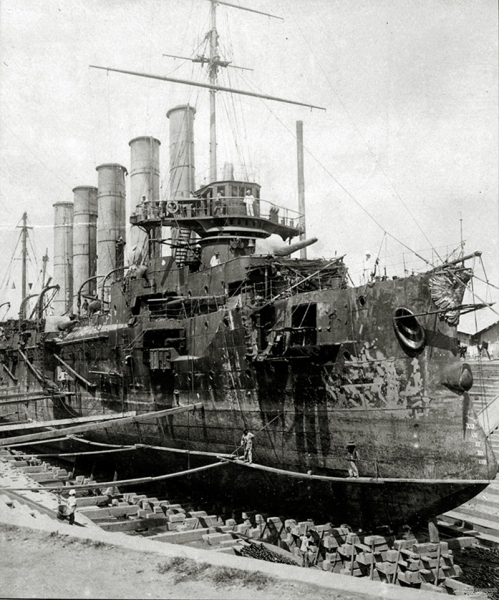
I-protected cruisers rank “Askold” Qingdao
People in the cellars of working in confined spaces, not knowing, what was going on upstairs. Even in the worst conditions were machinists and stokers. When a large shot has hit the upper part of the fifth pipe, a fifth of the blower stokehold flashed flame and smoke filled compartment. But due to the excess pressure thrust quickly recovered. In the boiler number 8 fragments, proletevshymy through the lattice armor, punched cover and a few hot-water pipes, which gave a slight hover. Hole in the casing of the boiler was small, and, not to reduce speed at a critical moment in the battle, boiler left in action. From the conning tower all the time required to hold more progress. Forcing boilers maximum allowed. air pressure reached Kochegarka 80 mm water column.
Combat vehicles Watch team had no change. Some machinists working without a break anymore 16 hours. “Drivers had to be pumped in the end every 15 minutes with cold water. Many went to the touch - so then ate at the eye. With some of the fatigue made seizures - had souse of a hose, and thus bring to life ". - testified to the chief engineer.
After the fight Nikolai Reitsenstein wrote in a report to the Naval Staff of the "Askold" teams and the "Novik": "Trueheart can not specify both of these distinguished cruisers: commanders, officers, mechanics, the doctors, lower ranks behaved bravely, Well done, in cold blood, without the hassle, smashing the enemy, their duty ".
The road was blocked in the open sea is now only the 6th detachment cruiser. "Askold" turned sharply and "ran to the cruiser" Suma ". the, as the previous, underway stepped aside, He cleared the way. enemy ships far behind, but for some time continued to fire. AT 19.40 in the logbook entry appeared: -Broke through enemy kreysera-. In the gathering darkness it has become more difficult to direct tools, the intensity of the fire fell, Japanese ships gradually lagged. AT 20.20 "Ceased fire, because the enemy is hiding in the darkness. "Novik", "Pallada", "Diana" is not visible behind the dark ",- vahtennom recorded in the journal "Askold". "Novik" followed his flagship to 01.30, then fell behind because of faults in the mechanisms.
At dawn 29 July turned out, Japanese cruiser "Akashi", Ideumi ', "Akitsusima" continue to pursue the "Askold" But, unable to bear the combat with cars Russian cruiser, they disappeared over the horizon in a couple of hours. Finally askoldovtsev have the opportunity to look around and count losses. It turned, that the breakout cruiser got heavier damage, than we expected at night. In the battle killed one officer, ten sailors, wounding four officers and 44 sailor. The guns fired at the enemy 226 explosive 152mm, 155 steel 75 mm, 65 cast iron and 75 mm 160 47-mm shells. Immediately after the break in the line were four 152 mm cannon, per night managed to restore another. N cannon 10, fully serviceable, could not shoot because, that burst under them shell smashed reinforcement and deck.
The gun-deck officer in the separation of fragments hit and exploded behind the gazebo on the elevator rails 75-mm cartridges. Battlestar lost both ranging stations, in many places the electrical wires were killed, divided 10 combat dials – ie disabled artillery fire control devices.
The starboard "Askold" had four small holes in the underwater 7 - 10-go špangoutov, through which the water in the room boatswain pantry. Between 83 – 84-m frames holes are above the waterline, but as a result of deformations parted casing joints, and water to the coal pit. Between the 28th and 29th frames projectile struck outside board three meters above the waterline, damaged and destroyed cabin mount under 152 mm gun.
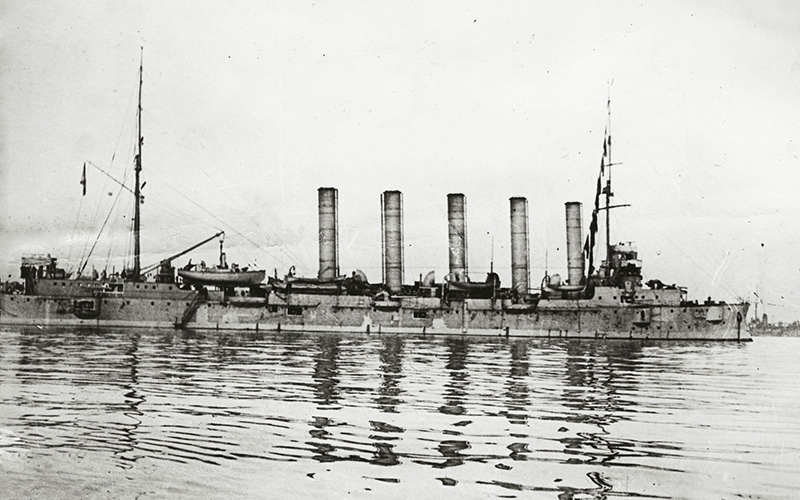
The cruiser "Askold" as part of the Allied squadron during operations Dardanelskoy. 1915 year
At the left side there are two holes in the underwater 32 – 33-m 46 - 47th frames. In these places,, except for an area of damage obshiaki 0,75 m, They were killed themselves frames, rasşatanı bimsı. In the department of underwater vehicles through the deformed rivet received about 3 t of water per day. This hole was especially dangerous, because it was just three meters from a small holes, received 27 in January and only temporarily embedded without restoring the broken frames. Total cruiser took 100 tons of water, what, but apparently it did not have much - no list and trim. Armor deck ostalas nepovrezhdennoy.
Sad picture represented pipe cruiser. 1-I killed off and flattened at the base, all the pipes are broken backstay, so I am keeping it a miracle. Fragments caused a lot of small injuries. 2-I. 3-I. 4-I pipe in many places were breached and large fragments, like pockmarks, dotted with small. 5-I pipe is shorter by one-third. A significant loss for the team was the complete destruction of the two plates kambuekyh. Boats and boat looked like a sieve. Yet cruiser could reach a speed up to 15 knots. Adopted a report on the state of the ship, convinced Nikolai Reitsenstein, that "Askold" not in a position to fight, breaking through the Korea Strait. Danger was simply swimming and rough weather in the ocean. Therefore, we decided to go to Shanghai, to correct the most significant damage, restock and then try to break through to Vladivostok around Japan.
At noon 30 July 1904 year "Askold" was anchored at the mouth of the river Vuzung. A few days later Nikolai Reitsenstein received orders from St. Petersburg to disarm the ship. As a matter of fact, there was no choice: repair yet nearing completion, and in Shanghai has already appeared a squadron of Rear Admiral Urpu as part of the armored cruiser "Tokiwa", two protected cruisers and two destroyers. 11 August "Askold" and came soon after him Destroyer "Lightning" to lower the flag. locks guns, fighting compartment minutes Whitehead, rifles and some machine parts removed and handed over to the Chinese arsenal, 28 August cruiser was taken from the dock at the pier and set Russian society CEL with "ThunderClan" and interned at the beginning of the war gunboat "Manchuria".
Repainted in white color of peace ships stood here for more than a year. Only 2 October 1905 in Shanghai received a notification of the ratification of the peace treaty between Russia and Japan. 11 October at the "Askold" again raised the flag of St. Andrew, a 1 November, under the command of the commander of a new captain 2 K.V.Stetsenko rank cruiser came to Vladivostok. Because of the revolutionary events in Vladivostok "Askold" was detained in the Gulf to Slavic 15 November. And immediately on arrival at the port began firing sailors, who have completed their required deadlines. For two weeks the cruiser left about 400 human. 9 December "Askold" enrolled in the individual units of vessels for the protection of the Ussuri region. 24 May next year cruiser, consisting of the time of construction in the Baltic Fleet, He was transferred to the Siberian flotilla, and his team – Siberian naval crew. Summer "Askold" a few times out in the Amur Bay in the practical shooting, rounds coming to Vladivostok Bay, and half of autumn spent in dock.
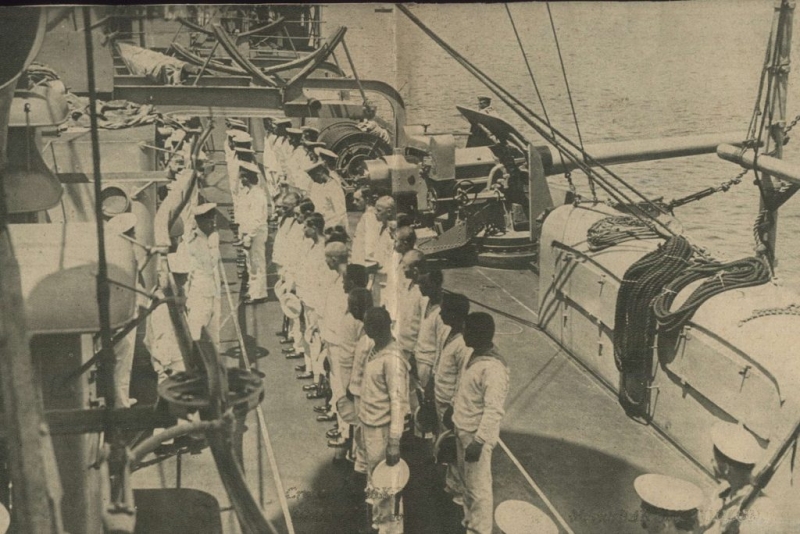
Presentation of awards to sailors "Askold" 1916 year
At noon 1 February 1907 year "Askold", headed by the new commander – captain 2 rank S.A.Glizyanom – I came out in the first post-war long march. After sunset in Shanghai went to the shores of Indochina. Here 15 Martha, following in Saigon by posting a pilot. "Askold" stranded in villages, not marked on the map. Attempts to get her, working machines back, first result did not give, but after about an hour the tide freed Cruiser. Subsequently, when docking between the horizontal and lateral keel starboard found dent length of about 40 m. considered, that the effect on body strength and performance of it has no, so we decided not to fix. Back On WAYS "Askold" posetyl Hong Kong, Without being disturbed, Shanghai and Qingdao 30 April saluted, entering the Golden Horn. Loans for a swim in the current year, the cruiser spent, so with 1 June atonement in the armed reserve. Part of the team written off in the carriage, remaining the same, along with the port workers engaged in repair of machines and replacement of 152-mm guns.
17 October of the crew took part in the uprising in Vladivostok. Several lower ranks were arrested and put on trial. Seven were sentenced to death, many received various terms of hard labor. The commander of the cruiser, accused of not taking decisive action "to end the unrest", be tried. 25 January 1908 , the captain 1 S.A.Glizyan rank was shot in the commander's cabin. During 1908 year "Askold" the first nine months stood in the armed reserve and only for three – from 20 August 20 November - including "floating". Now cruiser was assigned the role of a leader, because after leaving the Baltic survived the Russian-Japanese war ships he remained the largest and most powerful combat unit of the Russian fleet in the waters of the Far East.
In the navigation 1908-1910 s "Askold" several times went to sea on trials machines, military training and inspection of the Primorsky Territory bay. Current repairs are carried out by personnel with the assistance of the working port. However, the technical condition of the machinery with worse every year. therefore 1 January 1911 the cruiser stood on major repairs. By September 1912 it produced the first replacement of tubes in boilers, manufactured and installed new chimneys, We looked over main and auxiliary machinery, We removed the side surface mine phones and two 47-mm guns with a nose bridge, equipped with roll alignment system, repaired in dock outboard fittings, steering wheel, installed new seals and replaced bokaut in the stern tube. By the end of the repair crew reached the full state, and its members appointed top sailors from other ships of the fleet as a reward for good service. 22 September “Askold "went to sea on the test mechanisms. but, in spite of the repair time, with an increase in speed over 80 began to bask crank bearings, and managed to reach a speed of only 17,46 host.
9 November 1912 of the year “Askold” He came into practical sailing with students noncommissioned officers from: Vladivostok - Shanghai - Hong Kong - Saigon - Singapore - Batavia – Sabang - Manila - Qingdao - Vladivostok. for 3 month and 21 day cruiser passed 11 038,5 dear, without any serious damage in machinery and boilers. state machines to the end of the voyage was much better, than at the outlet of the overhaul. In October 1913 the cruiser out on the test mechanisms and has a top speed 20.11 host.
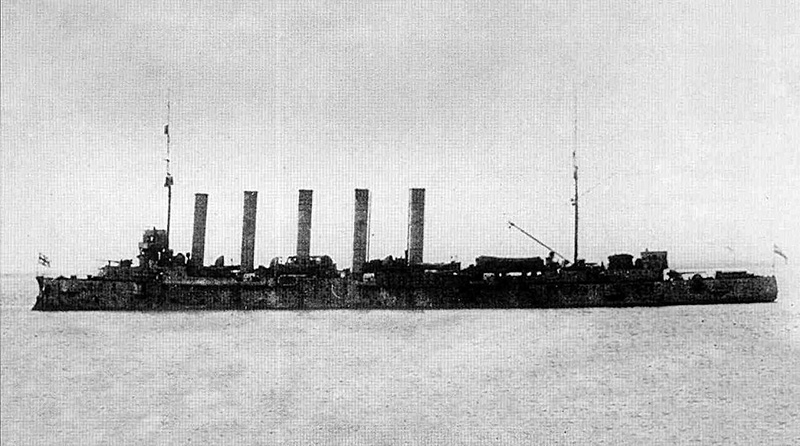
Cruiser "Askold" (Glory IV) under the English flag, August 1918 of the year
The third study overseas voyage “Askold” It continued on the route Vladivostok - Wonsan – Hong Kong - Saigon - Padang - Batavia - Surabaya - Manila - Vladivostok four months: from 1 November 1913 till 28 February 1914 of the year. In his last peaceful educational campaign “Askold” I was 10 711 miles. Only for 1913 Year cruiser had 1686 running hours and passed 17 226 miles. On his return to Vladivostok 1 March cruiser stood in the current repairs, but already 17 April again put to sea for training, taking on board the young sailors. 28 April collision with minelayer "Mongugay" "Askold" was damaged and was put in the dock.
In winter 1914/15 It was planned another training voyage, but the outbreak of World War I made adjustments to these plans. 12 August cruiser "Askold", "Pearl" and the steamer Voluntary "Poltava" fleet came from Vladivostok for joint operations with allied forces against the German cruisers in the vast Pacific Ocean. Shortly before going to the command of the "Askold" came the captain 1 rank S.A.Ivanov. Replenished coal reserves in Hong Kong, cruiser went into independent cruising ships to search for miners,, supplied the German squadron of Admiral Spee. "Askold" in the area east of the Philippine Islands for the whole campaign met only one US coastwise steamer. On his return to Hong Kong Ivanov received an order to follow in Singapore, convoying transports with troops and military cargo. In September-November, "Askold" several times in convoys crossed the Indian Ocean, then at the request of the Allied Command moved into the Mediterranean Sea for action at the coast of Syria and Palestine in order to destroy enemy ships and shelling of the coastal settlements, had military significance. 1 December 1914 year signalmen cruiser spotted at Haifa port anchorage anchored boat. fearing min, Ivanov ordered to lower trawl boats and approach to raid. "Askold" anchored in 55 cables from the shore, and to the steamer was sent by boat number 1 under the command of midshipman S.K.Kornilova with the evidentiary team.
Under the guise of cannons induced to shore cruiser boat came alongside the ship, who turned the German, under the name "Haifa" (displacement 1917 t). The vessel was arrested and taken to Port Said. The next day on the roads of Beirut Boat N ° 1 under the command of midshipman V.Shtaera looked through and put to the bottom of the two explosions blasting cartridges small Turkish boat. another boat – "Syria" - the cruiser took in tow and brought into the open sea. At the same time a midshipman on a boat number S.Bulashevich 2 inflicted courtesy visits to standing on the roads of the American cruiser "Port Caroline" and the Italian "Calabria". Dilute the pair to "Syria" failed due to damage to the boiler. Therefore, after removing the prize crew boat let a few shots to the bottom.
Not just boats cruiser fired from the shore by Turkish troops. In response, "Askold" guns bombarded military targets and enemy troops. 2 January fire main fire had destroyed the railway bridge at the mouth of El Bvrid in Tripoli River. In January 1915 Year in Persian steamer "Persepolis" askoldovtsy arrested ten Turkish soldiers and took them to Alexandria. Together with the ships of the Allies "Askold" conducted exploration, He carried on patrol duty at the Turkish coast, planted subversive groups, entering and fights with shore batteries, He fought the contraband of war, dosmatrivaya merchant ships off the Bulgarian coast (while this country had access to the Aegean Sea), Greece.
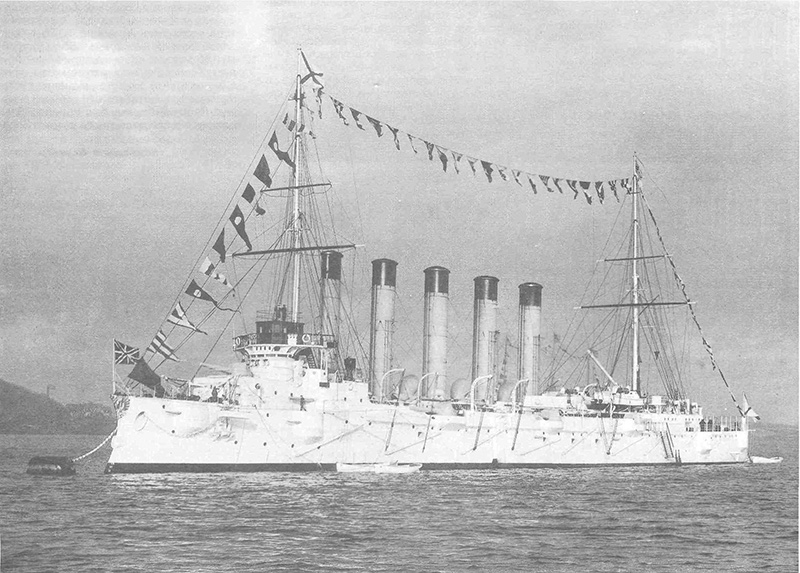
Cruiser "Askold" on parade
But the most notable event in the career of the cruiser was involved in the Dardanelles operation. "Askold" entered the 6th Squadron of the allied fleet under the command of the French Rear Admiral Gepratta, represented among 200 ships and ships of the Entente armed forces of Russia. 12 April Russian cruiser boats were sent to the landing at Kum Kale, and he took ship destination for conducting artillery fire. Boat with the "Askold" the first to come to the shore. The first wave of troops rushed to the attack, but then began to speak Turkish batteries. Askoldovsky boat was sunk by a direct hit. Promotion units landing on shore are also hampered by gun, installed in the mill. But Russian cruiser is the first successful salvo destroyed her, and the gun fell silent.
Never in its history, as he did not shoot: for 12 April has been spent 748 152-mm 1503 75-mm shell. On Turkish positions during the day, attacked heavy fire. It is among the ships of the 6th Squadron, "Askold" confirmed its good reputation, causing surprise allies within their volleys. The next day, the shooting continued along the shore, and as a result of fire, "Askold" and the auxiliary cruiser "Savoie" about 500 Turkish soldiers surrendered. On successful cruiser jointly with allies Marine Minister reported to the king. Nicholas II personally wrote the report; "Declare commander, officers and crew of the cruiser "Askold" my warm gratitude for the military service ".
Until the end of April, "Askold" continued to operate in the Dardanelles. Several times he entered the strait and was shooting at the Turkish batteries on the Asian shore, covering the Allied troops on the Gallipoli peninsula. Fate once again favored the ship, surviving among adrift minutes and tens of ruptures projectiles. Team working to 70 People sailors askoldovtsev went into the thick - on the Gallipoli Peninsula. Loss of the crew of the Russian cruiser was small: for all the Dardanelles operation was killed 4 and wounded 9 human. In May, "Askold" cruising in the Bulgarian coast, then he made a trip to Toulon, where a small repair was made, and he returned to the eastern Mediterranean, completing numerous assignments Allied Command.
By this time the Mediterranean became more active German submarines. U-21 under the command of the famous submariner Hörsingen had the opportunity to attack the "Askold". But the commander did not want to prematurely reveal its presence in the area and began to look for a larger goal. His victims were British battleships "Triumph" and "Majestic". When he decided to, it was the turn of five-funnel cruiser, find the "Askold" he failed to. 20 of July in Port Said to come from the Far East mine layer "Ussuri" "Askold" took ammunition. In September, once again it was the Mediterranean Sea, delivered IZ lounge in Toulon and Finance Minister Back P.L.Barka. During a campaign the minister handed the captain and officers of the awards for brilliant action entrusted to them ship.
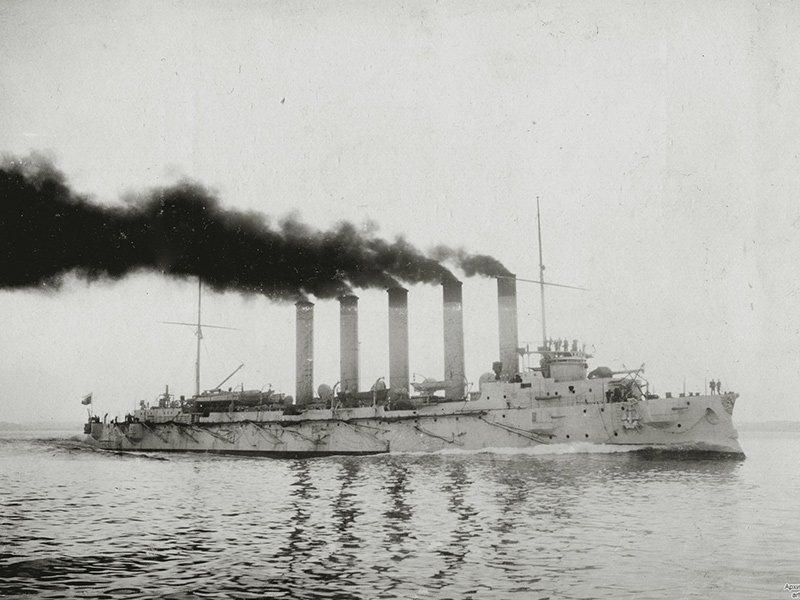
In early October, the cruiser participated in the allied fleet off the coast of Bulgaria operation, and entered the war on the side of the Central Powers unit. 15 January 1916 of the year 21 People with the "Askold" participated in the allied assault, take a Greek forts on the capes of Kara-Burnu and Tuzla, 20 January, they returned to the ship, but the unit was sent to guard the Russian consulate in the fort of Tuzla and the two officers 40 sailors. It was assumed in the case of a decision to take the allies to use Chalcedon Peninsula squad to monitor the coast and protect Russian Orthodox monasteries. It ended the most stressful year of the cruiser service. During a year 294 day cruiser was in a state of combat alert, with guns ready to take action and change the command line of duty. for 1915 year of his guns were fired twice more shells, than in all previous service cruiser, including the Russian-Japanese war! And all shooting carried out without serious damage materiel. Despite the difficult conditions cruiser military campaigns, located far from the homeland, Thanks to the efforts of the medical service, for 1,5 year, no member of the crew died of disease. At the same time British and French ships do not just have half-mast, and the cemetery island of Lemnos to appear more and more grave. With the "Askold" only four people have written off due to illness, TB patients. If earlier in the ship's infirmary on average per year lay 150-190 patients, then for 1915-th - just 23.
By the end 1915 , the main engines and auxiliary machinery cruiser needed overhaul. therefore 21 January "Askold" and left Thessaloniki 26 I arrived in Toulon. After the organizational issues in March began repairs at the "Forge and Shang-washing". cruiser team to do more work on dismantling, unloading and subsequent assembly of the three main parts of machines, and tungsten bearings and numerous support mechanisms. With the help of the Toulon arsenal experts were enumerated guidance mechanisms 152 mm guns, replaced all the ten 75-mm guns, set new sights Petrograd Metal specimen plant 1913 of the year. On the ship, there was anti-aircraft armament: wings mounted on the bridge 57-FEB mm English and two 47-mm cannon French protivoaeroplannye. For this it was necessary to reinforce the construction of bridges and move the spotlight. Cruiser has received new tools for learning French gunners 152-mm and 75-mm guns, apparatus for testing the loading rate of 75 mm cannon. Repair of the machinery was detained lack of skilled labor and the scarcity of materials in wartime.
After a difficult and dangerous service 1914 — 1915 Years Long-term parking in the rear port to aggravate the situation on board. If the common danger in military campaigns alike in officers and lower ranks, in conditions of relative peace and calm was something to think about. This difference in the material and social situation, and the fact, that the men continued to live in the ruined ship repair, and many of the officers and the commander lived on the shore, visited Paris, resorts of the French Riviera, some of them came close from Russia. weakened discipline, reduced service organization. The lower ranks have seen a significant difference in the position of sailors in the Russian and the allied fleets, We observed the life of a democratic country, We met with the revolutionary-minded immigrants from Russia. A chronic disease of the Russian Imperial Navy, which led to the events on “Potemkin”, “memory of Azov”, “ocak” and other Russian ships, It escalated in the summer 1916 year and “Askold”.
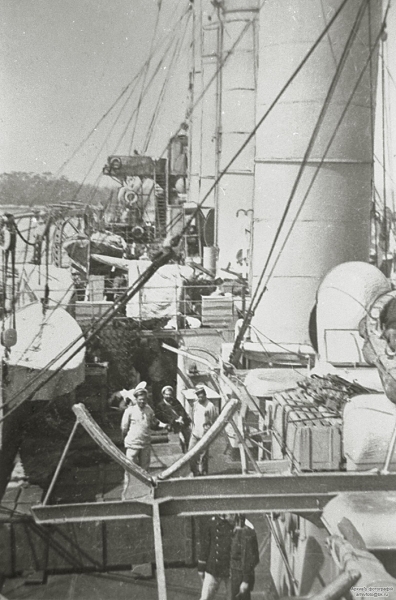
The command of the cruiser from different sources has been kept informed about the impending revolt on the ship. During a search of personal belongings of sailors found illegal literature, weapon. 9 August 28 human, suspected of dealings with political emigres and storage of illegal literature, deducted from ships and sent to Russia. 19 August, about 3 ugra hours in feed 75mm cellar, where there was 828 shells and about 100 000 rifle cartridges, explosion. With safety fuse unknown everted over an opening through the shock tube is ignited powder in the pocket of one of the unitary cartridges. The liner shattered, but the missile did not explode. Total has been damaged 9 unitary cartridges. On the morning after the blast arrested 28 human, later another 49. The commission of inquiry accused of involvement in the explosion 8 human. 10-12 September, the court, sentenced to death four people. The sentence was approved by the new commander of the cruiser captain 1 rank K.F.Ketlinskim. 15 September forte Malsbusk were shot D.T.Zaharov, U I.Beshentsev, EG and AA Shestakov Biryukov. 113 people on the same day sent via Brest to Russia. None of the convicts did not plead guilty, and direct evidence against them was not.
10 November successfully tested the machine on the drums, a 18 "Askold" started sea trials and developed 15 knots. The third outlet 10 speed reached in December 21 assembly at 120 machine speed, true, while basking bearings, but within 19 machine components operating normally. 5 December “Askold” He enrolled in the composition of the fleet of the Arctic Ocean, a 27 December, he walked out of the Toulon in England with stops in Gibraltar. In the Atlantic Ocean cruiser caught in a heavy storm. Huge waves were the bow of the ship, Shreds foam and spray flying above the pipe. One particularly strong wave deformed nasal superstructure. When 20 January 1917 year profit in Plymouth, in coal pits only remained 70 tons of coal. The next day “Askold” I moved to Devoiport. where the damage was corrected, received during a storm. Admiralty anchor with rods and cut-beams were replaced by English, Smith system, stowable in fairleads, as proposed by the German engineers is, the original draft of the cruiser.
On Revolution in Petrograd and the abdication of Nicholas II askoldoptsy learned from British newspapers, and only after the official telegrams Naval Ministry Ketlinsky ordered to build a team on the tank and the nose bridge has announced the latest developments in Russia, urging all to continue to do their duty to the Motherland. The commander put a lot of effort, to prevent the ship spontaneous actions against officers. At the request of some of the commands are written off from the cruiser. After that, “Askold” We took the oath to the Provisional Government. 23 May the ship moved to Greenock, from out in the bay for testing paravanes. Located close to Glasgow lived several thousand immigrants from Russia. They, along with the workers of the city enthusiastically welcomed askoldovtsev. The City Theater staged a rally, and train, which came sailors, It was decorated with flowers. Working Glasgow presented in a gift askoldovtsam samovar (Now it is stored in the Central Naval Museum in St. Petersburg) with an inscription: "Given the social workers and. org mi Glasgow with our Russian comrades "Askold" in memory of their stay in Glasgow. Scotland. May 1917 ».
4 June "Askold" moved to the Bay Holy Loch, where he held a number of exercises, and then left the water in England. 17 June, he went into the Kola Bay and dropped anchor about Murmansk. Almost three years continued its odyssey. After retiring in 1914 Far East, with the outskirts of the Russian empire and passed a thousand miles, visiting dozens of foreign ports, askoldovtsy set foot on the land of the Russian Republic, and they honored the ship became part of a separate detachment of ships of the Kola Bay Flotilla of the Arctic Ocean. Ketlinsky departed on vacation, and in command of the cruiser joined Captain 1 rank A.I.Sheykovskiy. Flotilla needed artillery guns for coastal batteries and armed merchant ships to repel the German submarines. Therefore, "Askold" was planned to remove the ten 75-mm anti-aircraft guns and four replaced by two 47-mm. To reduce the risk of detonation of ammunition in cellars in the production of combat injuries made the decision to remove the shells, charges and cartridges, is closer 1,5 m to the outer board. At the same time the main caliber ammunition was reduced to 1500 shots. Mechanical parts required replacement of boiler tubes, which expires in service 1918 year, and change some of the inserts and tungsten and head bearings. These works required at least two months.
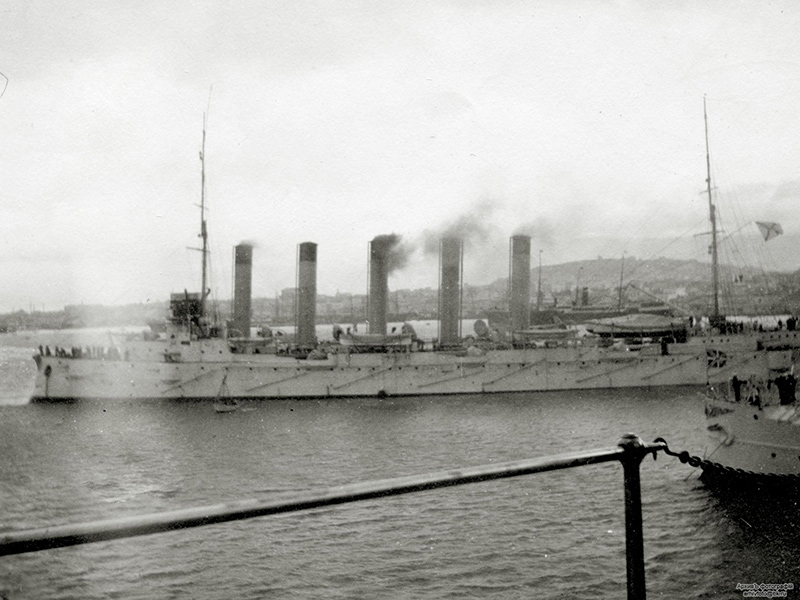
I-protected cruisers rank “Askold” on the Baltic Sea
The victory of the armed uprising in Petrograd on "Askold" became known 26 October. Askoldovtsy attended the meeting of social organizations in Murmansk, where a resolution was passed on the full support of the new government. After the armistice with Germany in December 1917 year began a partial demobilization of the fleet. Dismissed sailors older, designed in the years 1907-1910. The lack of personnel makes it necessary to withdraw from the fighting strength of the large fleet of ships. FROM 5 February 1918-th "Askold" was put on the heating (that is connected to the outer steam pipe) until April. 7 May the College of the People's Commissariat for Naval Affairs decided on the reorganization of the Arctic Ocean Flotilla. "Askold", together with "Cesme" (former Port Arthur "Poltava") It planned to transfer to Arkhangelsk and keep in a state of long-term storage. But it did not succeed due to the intervention of former allies. 14 July cruiser was captured by the British landing, American and French sailors.
After passing the Archangel "Askold" under the flag of St. Andrew, but with the English team, He moved to. A few days later it was raised by British naval flag. Some time cruiser, renamed "Glory IV», It served as a barracks ship for part of Slavo-British Legion. Evacuating its troops from the north, the invaders have withdrawn “Askold” and England, where it was used as a hulk in Grelohe (Scotland). White Guard command tried to return cruiser. 5 November 1919 , the naval attache in London N.A.Volkov reported in a secret telegram to General Miller: "According Admyralteystvo recovery" Askold ", but can not provide ammunition, since this type of guns manufactured in England, Admiralty refused to give the crew for delivering "Askold" north ". Make dispositions for a campaign 1920 of the year, Naval Commander Rear Admiral White Ivanov planned to get from England "Askold" tools, "Varangians" and minonostsev TEN, to establish five 152-mm on the barges and four - on an island on Lake Onega. Alas, White movement in the north collapsed faster, than these plans can be carried out.
AT 1921 England, the Soviet government offered to return the "Askold" and destroyer "Terrible" and "power", subject to payment of their content (protection). The command of the naval forces of the republic considered it desirable to return ships, to continue to use them in the Black Sea for the auxiliary service as an educational. The Soviet Ambassador in England LB. Krasin said, destroyers that without serious repairs to make the transition in Russia will not be able, "Askhold" is able to walk on his own.
In November, the embassy has asked the shipbuilder and authoritative scientist Krylov, are on a mission in England, with a request to inspect the cruiser and give an opinion, whether it is necessary to repair it for further service or sold for scrap. Krylov in the commission visited the ship and reported the results in Moscow. "Askold" toady put 20-year term, and as a combat unit is already outdated. Repair it required a significant investment. It was therefore decided to buy out the British cruiser and then sell for scrap in Germany. On the last days of the ship Alexey wrote in his memoirs: "In Hamburg, He is on trial handlebars Fletnera, I have seen, as the past we had a very close "Askold" on its cemetery. So I had to be at the maiden voyage of the ship, and the last of his passing…».
So last Cruiser concelebrated Russian service: currency, proceeds from the sale, It was used for the purchase of locomotives, needed to rebuild the country's economy.
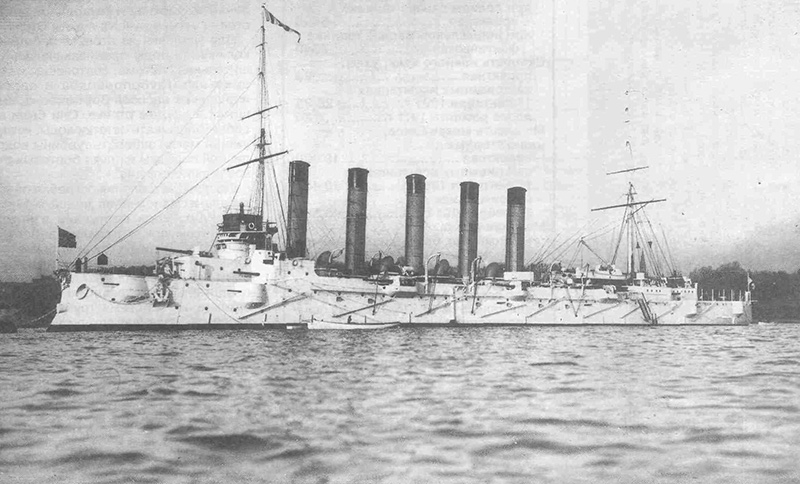
Cruiser "Askold" with raised flag of St. Andrew, jack and pennant
Tactical-technical characteristics cruiser Askold
– Manufacturer: «Germaniawerft», g. Kiel
– Construction started: 24 October 1898 of the year
– Launched: 2 Martha 1900 of the year
– Commissioned: 1902 year
– Status sold on the breakdown: at 1922 year
Displacement cruiser Askold
– 6000 t
The dimensions of the cruiser Askold
– Length: 132,5 m
– Width: 16,87 m
– Draft: 6,3 m
Reservation cruiser Askold
– deck: 51... 76 mm,
– deckhouse: 152 mm,
– guns shields: 25 mm
– armor Weight: 705 t.
Engine cruiser Askold
– three vertical steam engines; 9 Schulz-boilers Tornykrofta
– Power: 23 600 l. from. (17,6 MW)
– Dvizhitely: 3 screw
– speed: 24,5 assembly on trial
– Cruising range: 6500 miles (10-nodal progress), coal supply - 1300 t
– Crew: 580 officers and men
The armament of the cruiser Askold
Artillery
– 2 × 152 mm / L45,
– 12 × 75mm / L50,
– 8 × 47 mm,
– 2 × 37mm guns,
– 2 × 64 mm cannon amphibious,
– 4 pulyemyota
Mining torpednoe vooruzhenie
– 6 × 381 mm torpedo tube
Photo cruiser Askold
